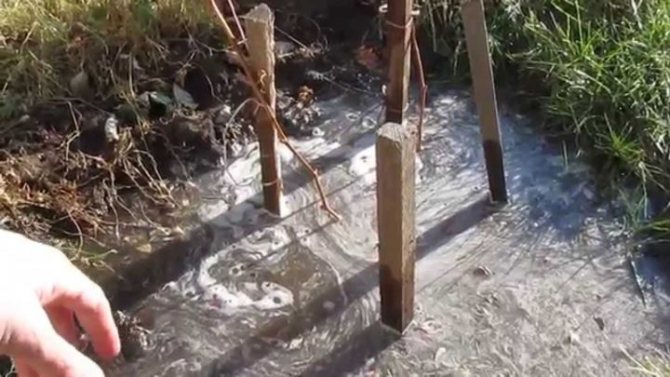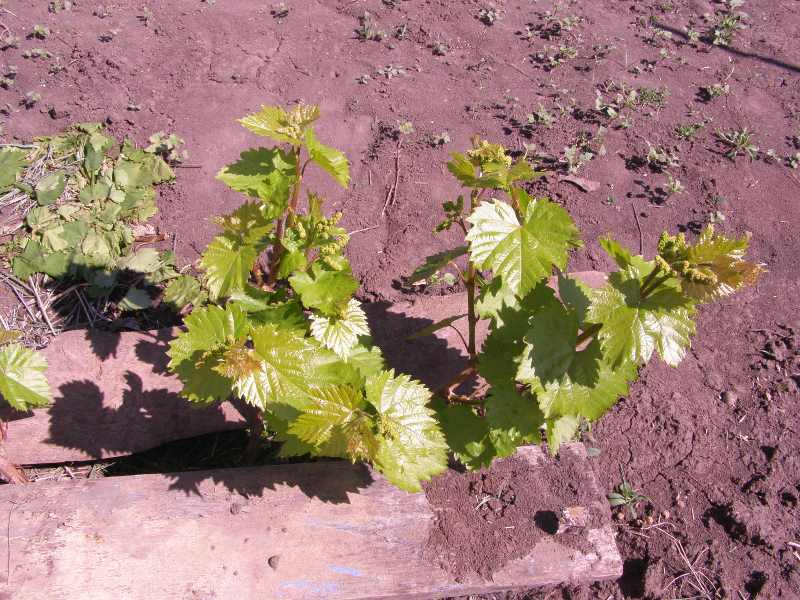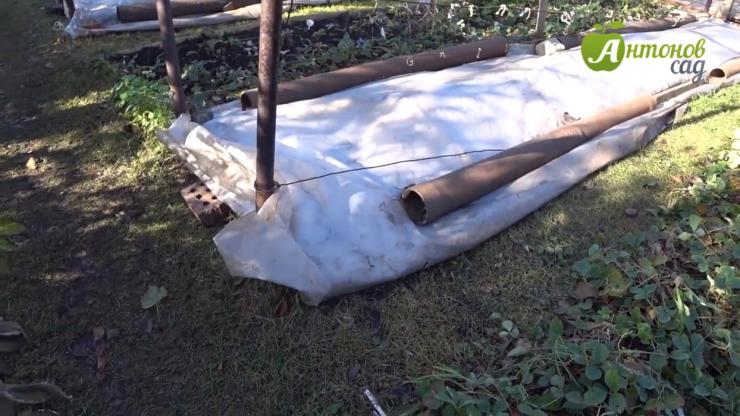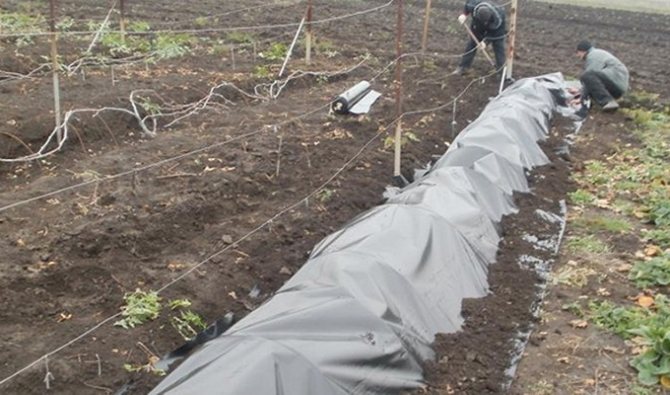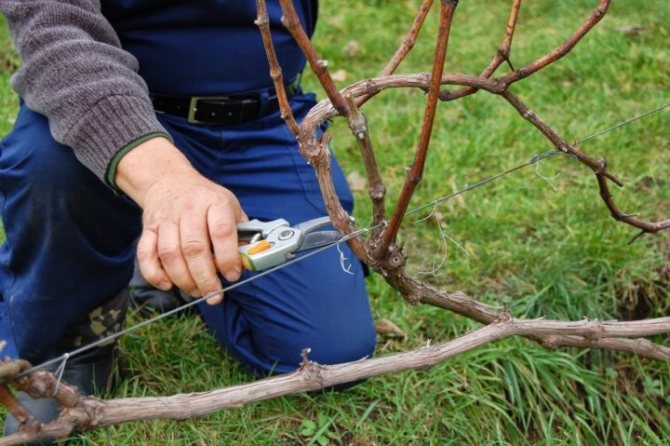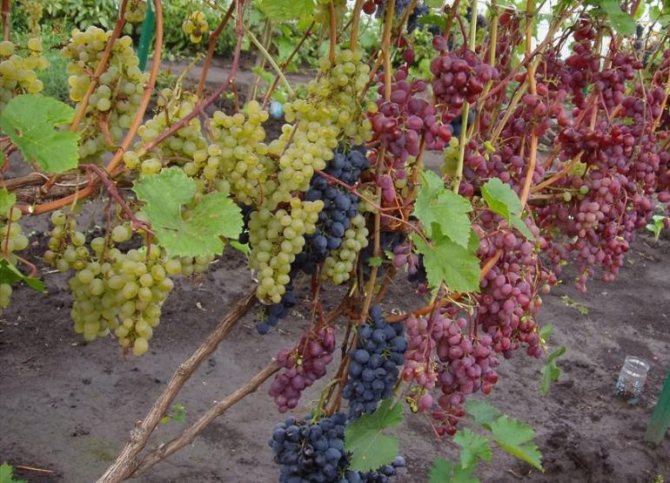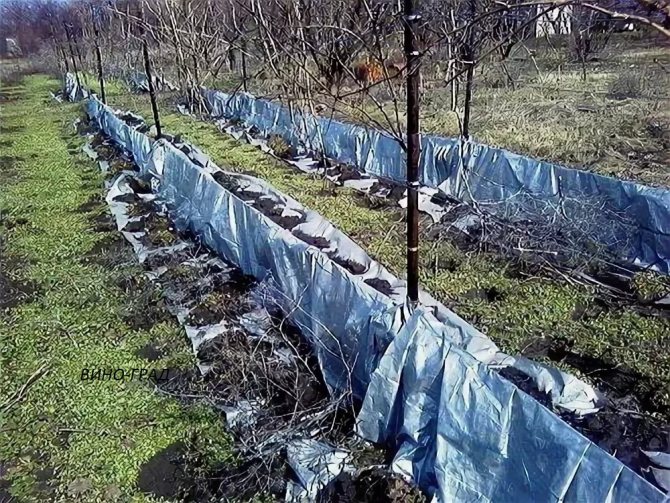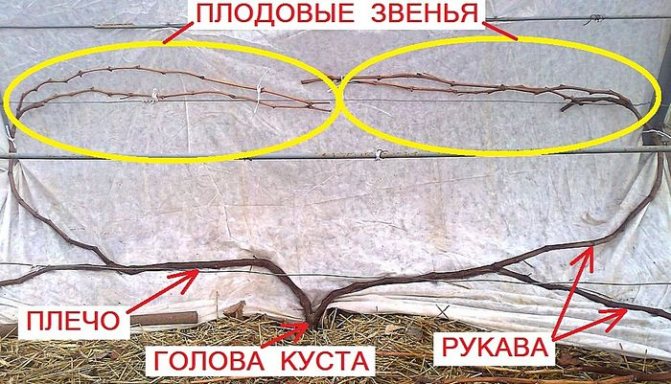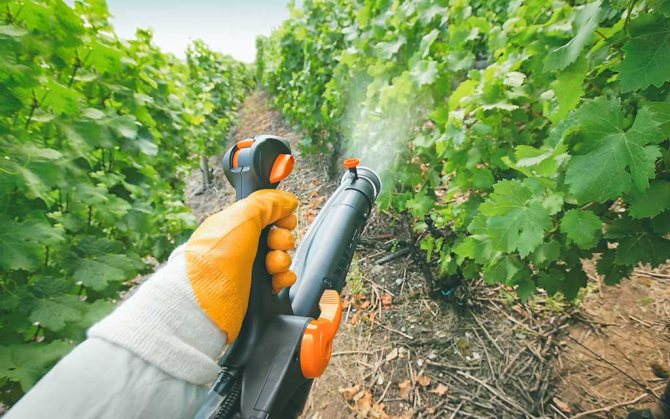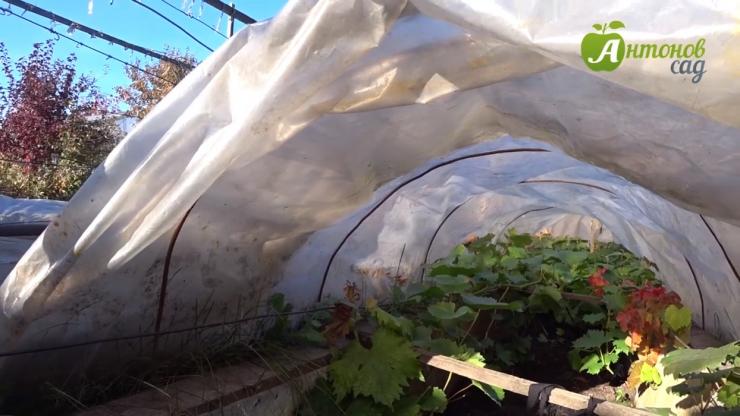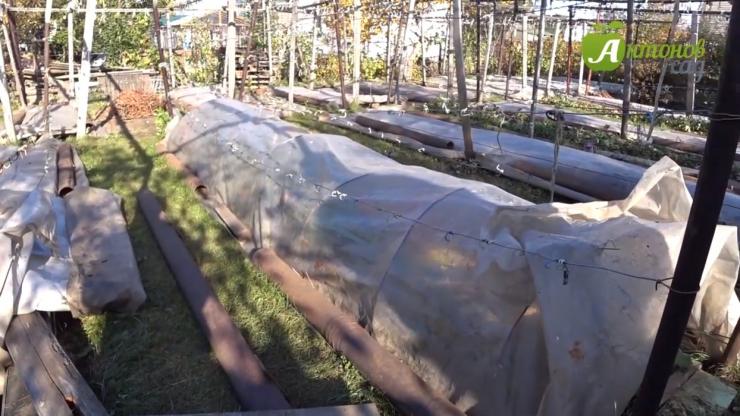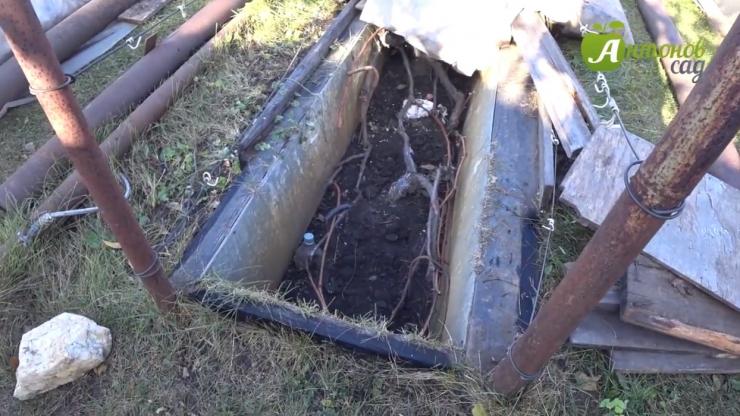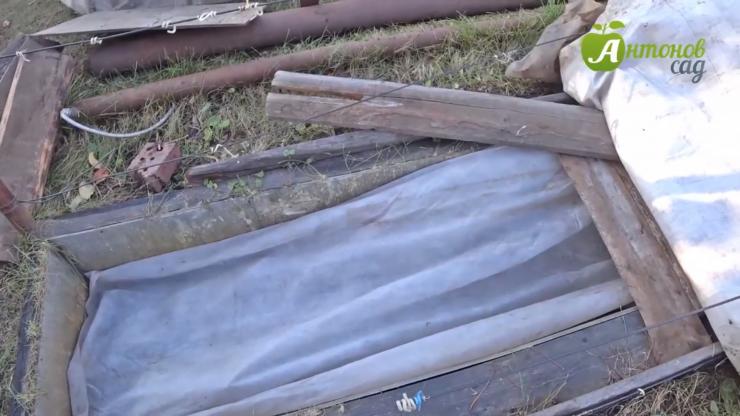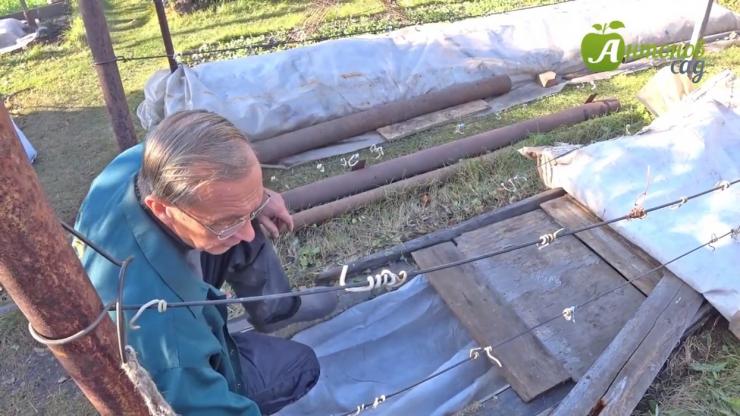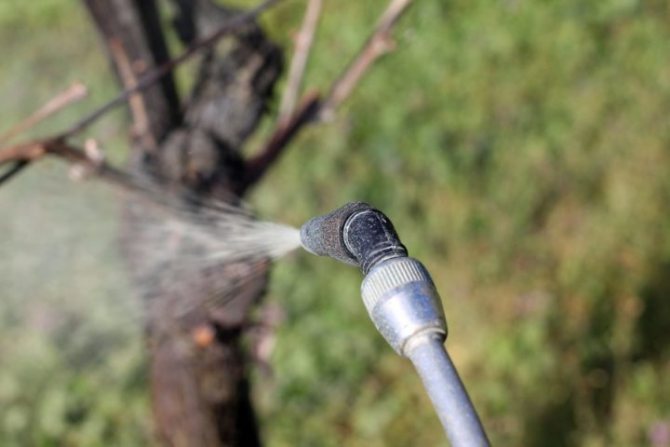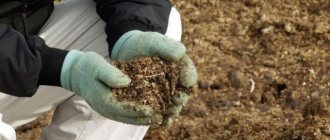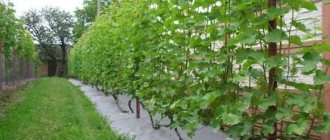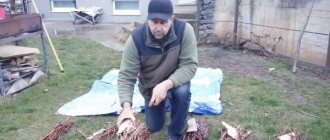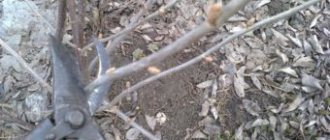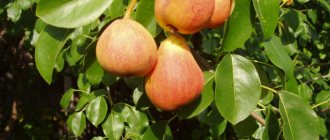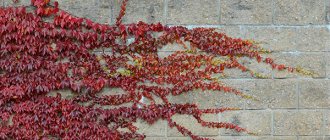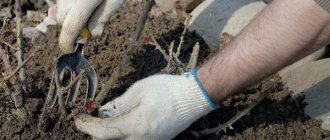Not in every region of Russia it is possible to grow a delicacy especially beloved by many - grapes, however, the southern part of the country has long been receiving large harvests of this sweet berry. Not only the correct selection of the variety determines the high yield of this garden plant, but also the correct care of the grapes in the fall. In this article we will talk about what kind of care the vines need in the fall and how to carry out all the necessary procedures.
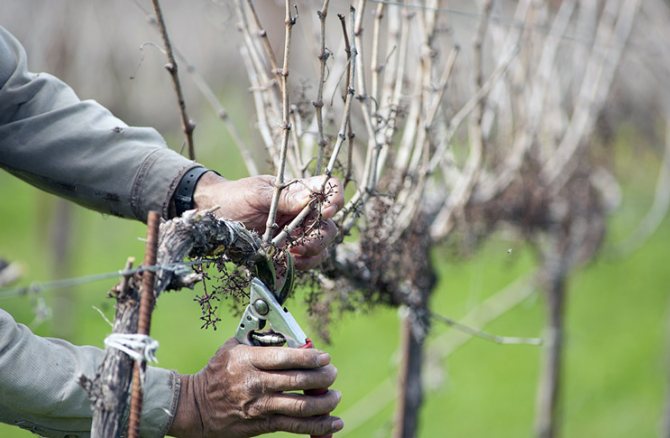
Grape care in autumn
Autumn watering
Regardless of whether it is old or young grapes, care in the fall, preparation for winter, first of all, requires water-charging irrigation. While berries are still hanging on the vine, it is strongly impossible to flood the culture with water. The berries will begin to crack from excess moisture. Wasps, bees, small flies will flock to the sweet juice and the crop will be spoiled.
Watering the grapes begins in the fall after harvesting the berries. Often it is not necessary to fill the bushes, but the soil should be kept moist. After the return of the crop, the roots require recharge. The quantity and intensity of watering are determined by growers intuitively, being guided by the weather, the state of the soil, the depth of the underground water layers. Despite all the nuances, in October, the vineyard is necessarily poured abundantly with water once. In order for moisture to penetrate exactly to the roots, grooves are dug in the ground around the bush or holes are drilled with a drill.
You need to take care of the grapes wisely, that is, do not pour water under the bush just like that. First, the composition of the soil is taken into account. Loose soil, sandstones absorb a lot of moisture and do not retain it. On such a soil, a grape bush is poured into 60 liters of water. Heavy soil with admixtures of clay or chernozem poorly permeates moisture, retains it. Vineyard care in such a plot is reduced to minimal watering. It is enough to pour 25 liters of water under the bush.
In the video, grapes, care in the fall, methods of water-charging irrigation:
Pruning goals
The grape pruning procedure is carried out for the following purposes:
- increased productivity;
- facilitating plant care;
- stimulating the growth of new shoots;
- rejuvenation of grapes;
- the formation of a plant, which improves its appearance;
- creating an optimal balance between the root and ground parts of the plant;
- ensuring the flow of nutrients.
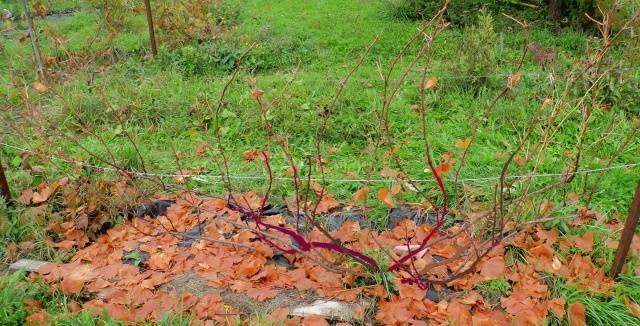

Pruning for the winter
One of the important stages of caring for grapes in the fall is pruning the vines for the winter. The procedure has the following positive aspects:
- After pruning in the fall, the bush is rejuvenated in the spring. The yield increases. The berries grow larger than uncut grapes.
- After pruning in the fall in the grown young stems, metabolism and the movement of sap occur more intensively. The berries ripen faster.
- Pruned vines withstand severe frosts better.
- A neatly shaped crown of grapes is easier to care for.
- Pruning diseased and diseased branches reduces the likelihood of disease spreading throughout the bush.
Leaving associated with pruning grapes begins after leaf fall. The vine goes into dormancy in the fall, and the removal of branches is painless. Before the leaves fall off, the branches cannot be cut off. Such withdrawal will only harm the culture. Until the bush has thrown off the foliage, the process of photosynthesis continues in the grapes. Early removal of leafy branches in the fall will weaken the vine.The grapes will not have time to accumulate useful substances that help to endure the winter easier.
It is also impossible to delay with leaving. Pruning too late with the first frost in the fall will cause unexpected damage to the vineyard. The vine becomes fragile in the cold. During pruning, the branch may crack in an unnecessary place.
Vine care begins with the removal of diseased, dry and damaged shoots. The branches are burned immediately after pruning, as they are infected with pest larvae and fungal spores. The next stage of care is the formation of the bush in the fall. In the vineyard, cut off the extra branches. The scheme for pruning a vineyard in the fall may differ for each variety, but in general terms, caring for a bush takes place according to the following principle:
- The load of the bush is regulated by shortening the annual branches. The two buds at the base of the shoot are not counted. They are not considered mature. For example, if a feature of a variety requires shortening the shoot by 4 buds, then taking into account two unripe buds, six of them are obtained.
- They start leaving in early autumn at the beginning of September. All young growth on the old vine is removed, the tops of which rise from the ground level by 60 cm. The branches, the tops of which rise 30 cm from the ground level, are shortened by 15%.
- Further maintenance of the grapes, related to pruning, continues in October. The process is aimed at the formation of a bush in the fall. Fruit branches and replacement knots are left on the vine. First, the lower strong, but short shoots with three eyes are cut off. The knots of replacement are obtained from them. The upper long branches on the bush are shortened by six eyes, forming fruit arrows. The eyes can be less or more, depending on the varietal characteristics of the grapes.
The cut sites are treated with garden varnish, which protects the wood from infection.
The video shows the care of the vine in the fall:
Pruning a grape bush in the fall
Pruning bushes is another item on our list of autumn care that must be carried out in order to spend a minimum amount of time in the spring restoring plant health, or planting new lashes.
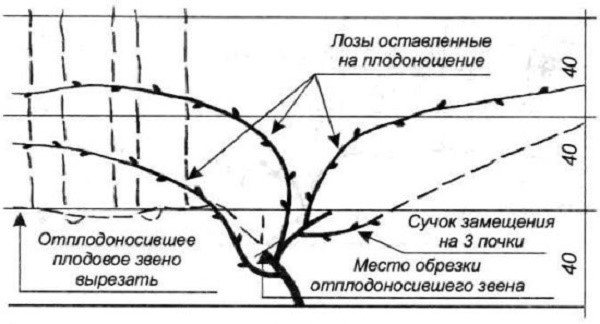

Grapevine segments
After carrying out this procedure, the gardener can observe the following positive effects:
- a significantly richer harvest for the next year, in comparison with the lashes uncut in the fall;
- rejuvenation of the bush and its growth, proceeding with renewed vigor;
- rapid ripening of the crop due to the fact that the movement of juice is much more intensive in young lashes;
- increased resistance to severe frosts;
- easy care for bushes;
- stop at the stage of development of diseases, damage from garden pests.
This procedure can be started only after the grapes have passed into a state of hibernation, that is, a few weeks after the plant has lost all its foliage. Until the specified time period, photosynthesis is still taking place inside the plant, which is not recommended to be interrupted.
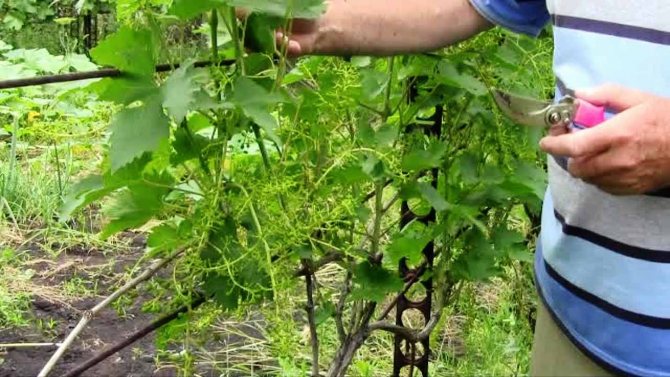

It is impossible to prune grapes thoughtlessly, otherwise the plant will simply die.
When to prune depends on the climatic conditions in the region where you live. So, the closer the frosts, the earlier you need to carry out the desired procedure, and vice versa. So, the standard time for circumcision is the end of September.
If you hesitate and do not prune until the first frost, then, catching yourself, and starting the procedure, you can accidentally break off the vines that are weakened by the cold, and completely in the wrong place.
During the pruning of the bushes, the removal occurs in stages. Let's see exactly how, in the following table.
Table 1. Stages of autumn pruning of grapes
| First stage | Second phase |
First of all, the grower who has started pruning must remove branches that:
| At the second stage, when the plant is cleared of pests and diseases, the shoots are removed in such a way as to correctly form the shape of the grape tree. You need to understand that not only healthy lashes are left to grow on the bush, but also young shoots, thanks to which new segments of the bush will form. |
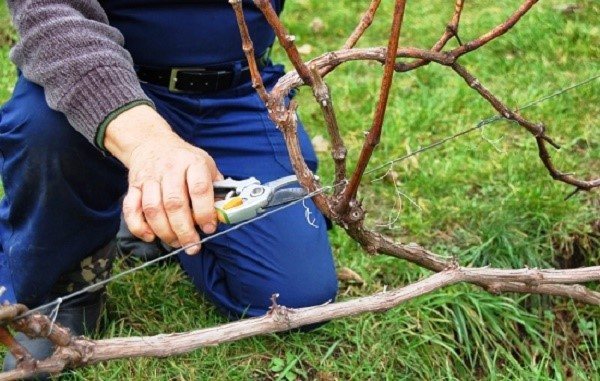

By following the rules of pruning, you will not only help the plant survive the winter, but also give it the strength to form a more abundant harvest next year.
In total, there are several important pruning rules that must be taken into account in order not to harm the lovingly grown plants. Let's take a look at them.
1. Do not remove the lower two buds from the vines, since at the time of the onset of the autumn period they are not yet developed to the desired state.
2. With the onset of September, by about the 10th, it is necessary to have time to cut off all the lateral branches on the old vine lashes, which are located at a level of about 60 centimeters from the ground.
3. In young green shoots, the top of which is located about 30 centimeters from the ground, it is necessary to cut off only the upper part, that is, no more than 15% of the total length of the lash. The lateral shoots departing from them must be cut off, keeping no more than two leaves.
4. In October, the plant will begin to tie fruit links. In order for them to develop correctly in the future, it is necessary to find strong shoots that have grown to a level of about 60 centimeters, and cut off the lower one so that only 3 eyes remain on it. We also cut off the top one, leaving 6 eyes on it.
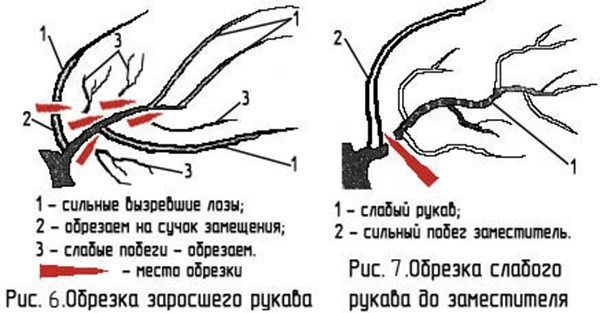

How to properly trim grape sleeves
5. With the onset of September 15:
- all young shoots are cut off, which at the time have reached a length of 20 centimeters;
- lashes that have grown to 30 centimeters are shortened by 10% of their original size.
6. In branches that have lived for a whole year, all protruding shoots are cut off, and only those that are located at right angles relative to them are preserved.
7. The dried top of the bush is also removed.
After you complete the procedure for cutting the plant completely, you will need to purchase a garden var, a resinous substance that protects plants from decay, and smear all the cut points on the plant with it.
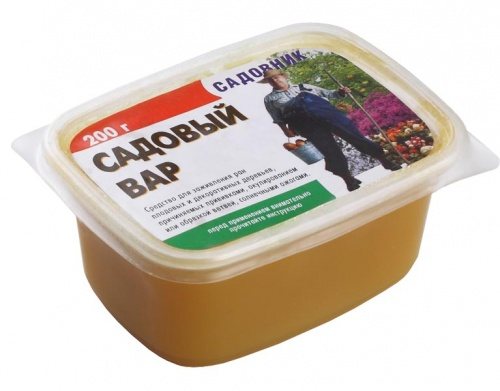

Garden var is a versatile remedy in the fight against any damage to the bark.
Please note: you should not cut out all the young shoots that have formed near the bush, since in the spring, if the main lashes are damaged by low temperatures, it is the fresh stems that will take on the role of the source of the grown fruits.
Prices for garden var
garden var
Top dressing and tillage
Taking care of the vineyard is not complete without top dressing. In the fall, after harvesting, the crop is in a depleted state. In order for the vine to overwinter and give a good growth in the spring, it needs to restore the lost strength.
Leaving in the fall means feeding the crop only with phosphorus and potassium. From mineral fertilizers, 40 g of superphosphate are applied under an adult bush. The substance enriches the grapes with phosphorus. From potash fertilizers, 30 g of potassium sulfate or potassium magnesium are applied. Many gardeners give preference to potassium monophosphate, contributing 40 g of the substance under the bush. Dry mineral fertilizers are diluted in a bucket of water, poured under the root, combining top dressing with watering.
Instead of mineral fertilizers, fertilizing in the fall can be done with organic matter. Under an adult vineyard, 300 g of ash or 15 kg of compost are introduced. The organic matter is dug up with the soil to a depth of 30 cm, departing from the trunk 50 cm.
Basic rules for pruning
A sharp garden pruner is required for fall pruning. The cuts are done in one stroke to get the most flat surface possible.For wounds to heal faster, they must be turned towards the inside of the plant.
Trimming time
The procedure largely depends on the region where the grapes grow. With the onset of autumn, pruning is necessary in cases where the vineyard is sheltered for the winter. As a result, the plant tolerates winter cold better.
Processing is carried out at the end of October, 2 weeks after leaf fall. If the vine has suffered a few mild frosts, this will only harden it.
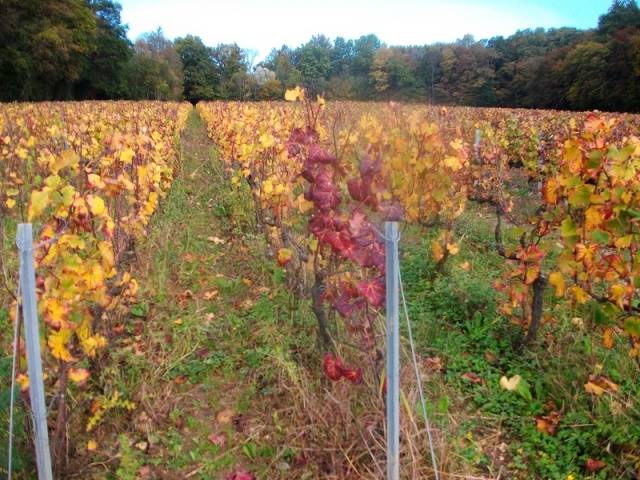

First, it is necessary to process varieties that are characterized by increased resistance to low temperatures. Then they move on to the rest of the landings.
Basic techniques
There are several ways to carry out grape pruning. The choice of technique depends on the degree of growth and the variety of plants.
- Short cut. This method has another name - "on a knot". Its purpose is to form and rejuvenate the grapes. As a result, from 2 to 4 eyes remain on the shoot. Be sure to eliminate the bends growing from the first peephole. In total, up to 40 eyes are left on the branches.
- Medium pruning. After the procedure, up to 8 eyes are left on the branch, while their total number on the bush is no more than 50. Thus, frost-resistant shoots are preserved.
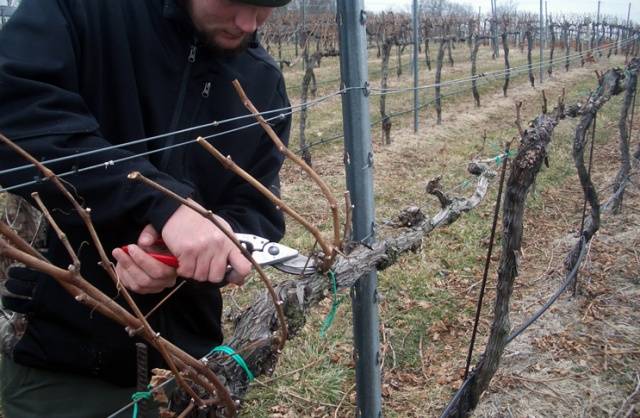

- Long cut. This method allows you to increase the fruiting of grapes. 15 eyes are left on each branch, and their total number should not exceed 60. Long pruning is more suitable for Asian varieties.
- Mixed media.
The most popular is blended cropping, which combines short and long techniques. Some of the branches are cut "on a twig", which contributes to the renewal of the plant. The rest of the grape shoots are pruned to increase yields.
Pruning according to the age of the grapes
The order of the procedure varies depending on the age of the plant:
- Preparation of seedlings. In the first year after planting the grapes, it is important to form two vines. We cut the shoots at a height of 40 to 60 cm. Then the plantings are pinned to the ground and covered.
- Pruning a two-year-old bush. In the second year, up to 6 new grape shoots are formed. They formed on the branches left behind in the past year. On each of them, 2 or 3 kidneys are left.
- Processing an adult bush.
Pruning grapes aged 3 years or more is carried out in the following order:
- After picking the berries, the plant is cleaned of weak shoots and tops that interfere with its development.
- In early September, on perennial branches, it is necessary to eliminate young shoots that have not grown to a wire located at a distance of 0.5 m above the ground.
- Shoots that have outgrown the second wire (it is placed 30 cm higher than the first one) are cut by 10% of the total length. Also, side branches are eliminated.
- In mid-October, on each branch of the grapes, the two most developed branches are selected, the length of which reaches the first two wires.
- The lower branch growing on the outer part of the sleeve is cut to leave 4 eyes. Thus, a replacement knot is formed.
- The shoot, located on the opposite side and above, must be cut off, leaving 5-12 eyes. This branch is called the fruit arrow.
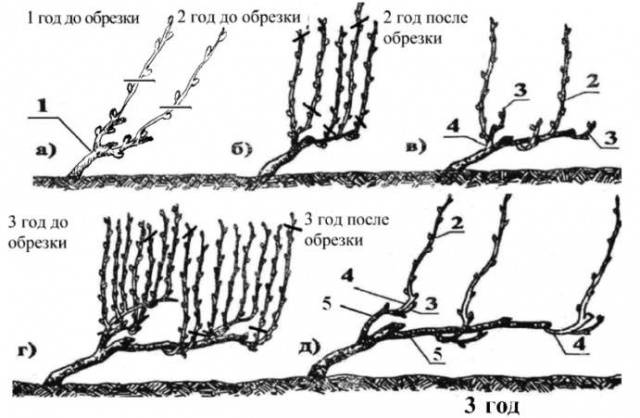

As a result, the most powerful branches and arms remain, from which new vines are formed in spring.
Another step in the procedure is the elimination of unnecessary mustache. With their help, grapes are consolidated and developed. If the plant is tied up, it is better to trim the mustache. However, it is better to direct them correctly so that the vine wraps around an arch or a gazebo.
Protection against diseases and pests
An important process of caring for grapes in the fall and preparing for winter is the preventive protection of the vine. The choice of a spray product depends on the condition of the vineyard:
- If, during the inspection, traces of mildew are detected, the affected shoots with leaves are cut off and burned. The vineyard is sprayed with "Folpan", "Ridomil" or another similar preparation.
- If signs of oidium are detected, the vine is sprayed with any preparation containing sulfur even before dropping the foliage in early autumn.
- Against anthracnose, drugs used to treat oidium and mildew are used.
- When, when examining the grapes in the fall, traces of a leaf roll are found, the bush is treated with a decoction of tobacco or medicinal chamomile.
- Sprinkling of berries and bunches in early autumn may be associated with cercospora. The disease still manifests itself as brown spots on the leaf plates. For the care of a sick vineyard, use "Fundazol". "Polychoma" helps a lot.
- In the fall, ticks like to get along on the vine. Most often, they sit on the tops of young branches. A measure of getting rid of the pest is pruning the tops of the shoots.
- In the case of the development of gray rot in autumn, the processing of the culture is carried out with "Euparen" or the preparation "Skala".
Healthy bushes also need preventive care. The vineyard is sprayed in late autumn after leaf fall with a 3% solution of copper sulfate.
How to ensure proper plant care after work
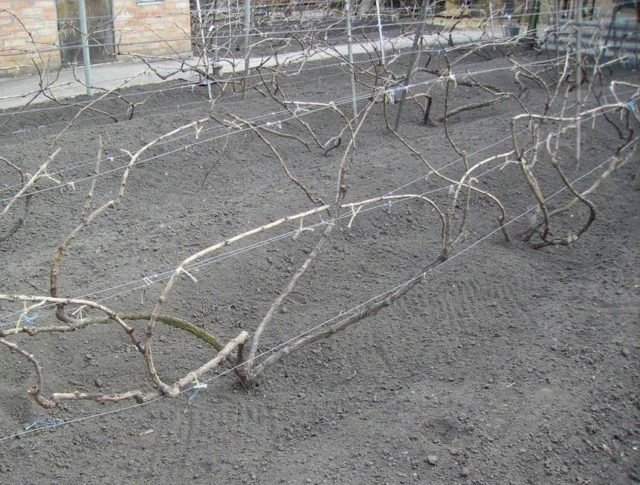

After the autumn pruning, the vineyard does not require special care, the main thing is to properly prepare the grapes for winter shelter. If the spraying of the vine with a solution of ferrous sulfate was carried out after the first stage, then the trimmed sleeves and lashes are neatly bent and pinned to the ground, leaving a small distance, the so-called air "cushion". If not, then the treatment is first carried out, and the next day the lashes are laid in the above way.
Further care of the bushes consists in the timely shelter of the vineyard for the winter.
In autumn, the grapes enter the final stage of the growing season and begin preparing for the winter. During this period, it is important to prepare the vineyard for winter, so that it endures frosts and begins to develop actively in the spring. Pruning grapes in the fall and sheltering for the winter are mandatory care steps.
To carry out pruning, you need to choose the right time so as not to damage the plants. The processing order varies depending on the age of the grapes. Other autumn procedures also include root system katarovka, treatment against diseases and pests.
Autumn activities at the plantation
How to care for grapes in the fall, what work needs to be done on the plantation, and in what sequence. Let's talk about this.
Even a novice gardener understands that the ripening of the crop requires a high yield of nutrients from the plant. It spends all its energy on filling the bunches. Therefore, care must be taken that the vine is not overloaded. Otherwise, the plant will leave in the winter weakened, which will lead to its freezing.
This is especially true for grape varieties with late ripening. After all, they have little time to prepare for winter. Some of the bunches will simply have to be cut off if, according to forecasters, a sudden cold snap is foreseen.
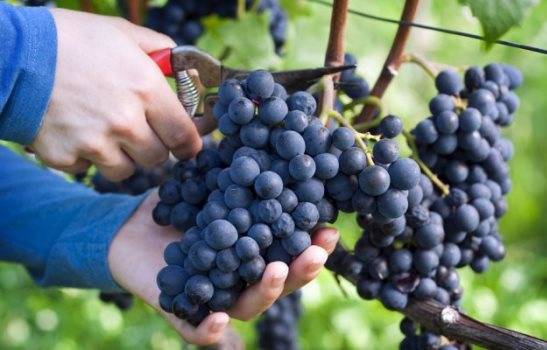

Watering features
Abundant watering of the grapes is needed when the bunches ripen. But excessive zeal is inappropriate, as cracking of the berries may begin. And this, in turn, negatively affects the taste and marketability of grapes.
Providing proper care of the vineyard in the fall, watering is not recommended to be ignored, especially if there is no rainfall. The soil under the vine should be moist enough to the depth of the root system. In this case, the plant is better prepared for winter.
Of course, the choice of the timing of irrigation and the amount of moisture during the autumn work on the vineyard will depend not only on precipitation. Here, the composition of the soil, the direction and strength of the wind, the air temperature in autumn, as well as the depth of the groundwater are of great importance.
Plants should leave well saturated with water during the winter.In the fall, many gardeners gird the grape bushes with grooves, then the water will go as intended - into the root system.
Each watering in the vineyard (in autumn too) should be accompanied by loosening of the soil. This will provide oxygen to the roots and allow moisture to stay in the soil for longer. For the same purpose, mulching of the trunk circle is carried out in preparation for the winter of the grape plantation.
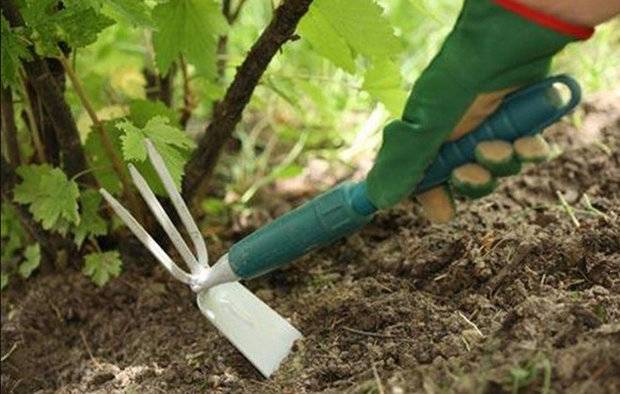

How to feed in the fall
It's no secret that grapes are grown in one place for no more than 6 years. But even during this time, if you do not carry out top dressing, the soil is greatly depleted, the plants weaken, and cease to yield. Even in one season, the vine draws a large amount of trace elements from the soil.
What needs to be done during autumn care to restore fertility when preparing grapes for wintering and to form the future harvest:
- First, the autumn feeding of grapes is carried out to saturate the plants with nitrogen, phosphorus and potassium. For this, use the appropriate fertilizers.
- Secondly, in the fall, grapes must also be fed with calcium, iron, magnesium, manganese, boron, copper and other trace elements.
The fall mineral diet can be replenished in two ways:
- fertilize at the root;
- carry out foliar feeding, that is, spray the plants.
Both activities related to plant nutrition are required when preparing a vineyard for winter. After all, at this time the harvest of the next season is laid. The better you feed the grapes before sheltering for the winter, the higher the yield will be, and the fruits themselves are tastier and more aromatic.
They take care of the vine, carry out top dressing not only in the fall. They are performed periodically during the entire vegetative period. When carrying out foliar dressing, they simultaneously take care of the fight against pests and diseases. Plants are fed in the evening when the air temperature drops. At this time, the stomata on the leaves are open, and the grapes better absorb nutrients. In addition, the absence of the sun protects the plants from possible burns when feeding on the leaves.
The last foliar dressing of grapes is carried out in the fall after harvesting and pruning, so that in winter the plants feel protected. The nutrients accumulated in the root system of the vine contribute to the formation of buds, the rapid ripening of the shoots.
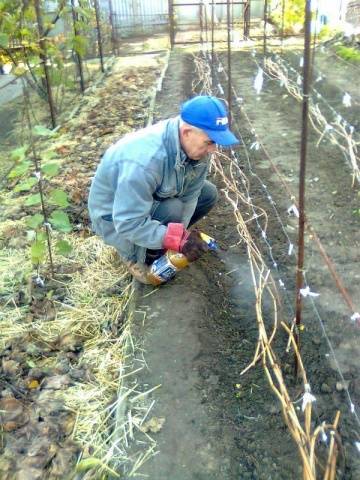

Autumn pruning
First, let's figure out why grapes are pruned in autumn:
- Firstly, the rejuvenation of the bush occurs, therefore, the yield will be higher.
- Secondly, the juice circulates better on young shoots.
- Thirdly, the plants are perfectly prepared for winter.
- Fourthly, a thinned vineyard is easier to care for, there are fewer diseases and pests.
Novice gardeners interested in the peculiarities of care are concerned about the time frame for pruning the vine in the fall. Immediately, we note that the care procedure must be performed when there are no leaves left on the grapes, that is, the time of rest comes. This means that sap flow stops, as does photosynthesis.
Not a single experienced gardener will be able to name the exact timing of the grape operation. Everything will depend on the region, climatic conditions and the time of the onset of winter. The main thing is to have time to carry out the autumn pruning of grapes before the first freeze and the night temperatures drop to 0 degrees. Otherwise, the vine will break during operation due to fragility.
How is pruning done
- first you need to clean the bark;
- remove shoots with the slightest damage, especially those who are sick and have not had time to ripen;
- whiskers, hemp, old shoots (four and six years old) are removed from the sleeves, leaving young shoots and replacement horns;
- there should be at least 16 eyes on each arrow, and 4-7 from below.
You need to work with a sharp pruner so that splits and bark bites do not form. After pruning, all cuts must be treated with garden varnish to avoid infection of the grapes.
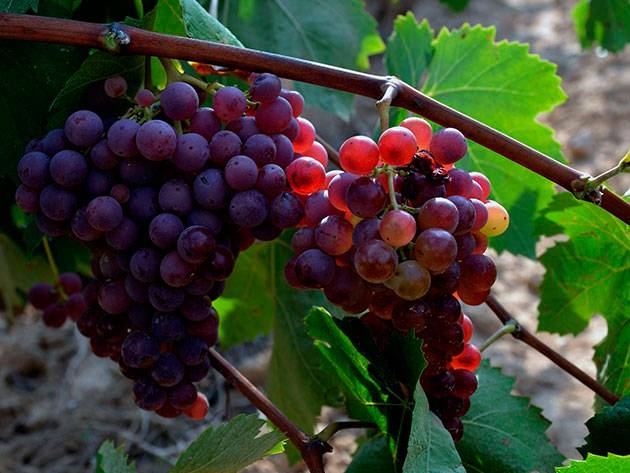

Disease protection
Grape care in the fall should be comprehensive. In addition to pruning, watering and feeding, plants need to be disinfected, to destroy spores of fungal diseases and pests. Otherwise, after the winter dormancy on the grapes, there may be an outbreak of diseases and an invasion of harmful insects that overwintered under cover.
It is not worth neglecting chemicals when caring for grapes in autumn, since only biological treatment will not give the desired result.
Preparations for the rehabilitation of grape vines during autumn care:
- Bordeaux mixture for cleaning from fungal diseases;
- Bordeaux soil and sleeve processing fluid;
- Dimethoate - destruction of pests when washing grape bushes;
- Fitosporin, Trichodermin, Gamair, Glyocladin;
- for the treatment of plantings of grapes, in the form of mixtures, working at a biological level in the autumn;
- Oksikhom, Actellik from ticks and itching.
How to cover an annual grape seedling for the winter
A young seedling is not able to withstand even slight frosts due to the fact that its bark is thin and the vine has not yet matured. Before sheltering for the winter, the remaining leaves should be carefully removed, and the vine should be cut into 3-4 eyes. Carefully huddle the soil and slightly loosen it. For one sprout, you need a 5 liter plastic eggplant with a cut bottom.
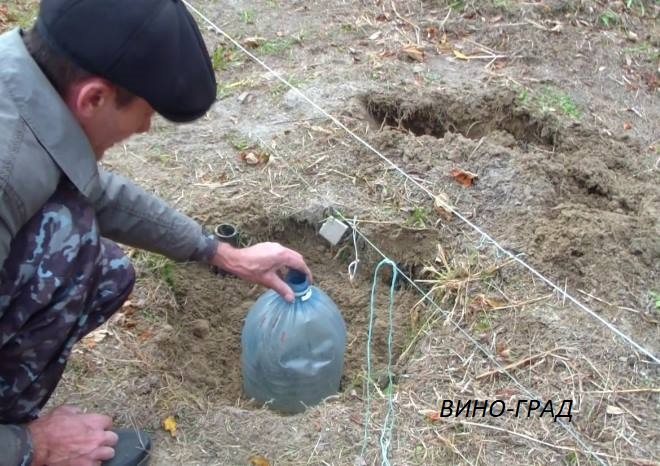

We cover the seedling with an eggplant, slightly pressing it into the ground, and on the sides we dig in with a thick layer of earth almost to the very top, leaving the neck free. When cold weather comes, close the neck with a lid or plastic wrap. This cover method is suitable for short cuts.
Trench shelter for grapes - video
Grape care in September and October
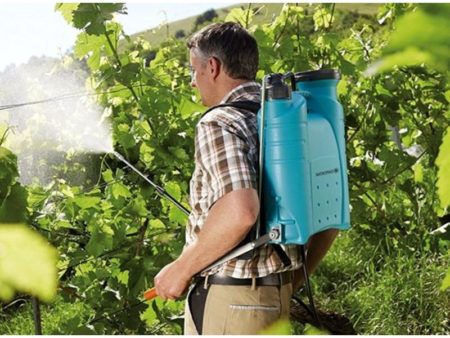

Autumn grape care has two goals: to lay the foundation for high-quality fruiting in the next season and to prepare the plant for the winter period. The bush is considered completely ready for winter if it is healthy, not affected by pests or diseases, has well-ripened wood, recovered the strength spent on fruiting, and went into a dormant state in time.
These objectives and growing conditions determine how to care for grapes in the fall. List of main works:
- the last top dressing of the season;
- pruning grapes;
- catarovka roots;
- protection against fungi and insects;
- pre-winter watering;
- shelter for the winter.
The quality of autumn care is especially important for late grape varieties, limited in time for wood ripening and slowing down of life processes. When grown in temperate climates, even medium-ripening varieties may not have time to prepare for winter. In view of this, it is recommended to follow two rules:
- It is necessary to start autumn work as early as possible - as soon as the harvest is taken from the vines. The preparation of early grape varieties must be started without waiting for the end of the fruiting of the entire plantation.
- Care should be taken in advance to ensure that the vines are not overloaded. If the plant spends too much energy on the ripening of the crop, it will be difficult to restore it in a short time. It is worth sacrificing the volume of the crop in favor of the bush and performing normalization by thinning the bunches.
Which grape varieties do not need to be covered
There are about 20 varieties that do not need to be covered for the winter, although just a few decades ago, such an assortment could not boast. And all this thanks to breeders who bred frost-resistant varieties by crossing that can withstand severe frosts.
Mostly uncovered are dark isabelle grape varieties. We described the characteristics and descriptions of the top 10 frost-resistant varieties in this article. The top includes:
- Lydia,
- Crystal,
- Taiga,
- Aleshenkin,
- Alpha,
- Sharov's riddle,
- Amur breakthrough,
- Blue North,
- Muromets,
- Pink pearls.
Top dressing of grapes in autumn
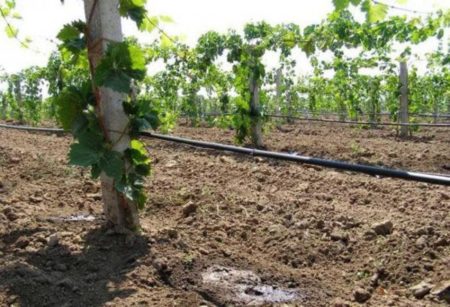

A grape bush, exhausted by fruiting, does not have sufficient resistance to cold and can freeze out during the winter.Under the shelter, conditions favorable for the development of fungi can form (for example, due to thaws), and in this case the health of the plants by the spring will depend on their immunity, therefore it is dangerous to send weakened grapes to the shelter.
In order to avoid negative consequences in September, the grapes must be fed. It is necessary to replenish the supply of nutrients, first of all - potassium and phosphorus, as well as calcium, magnesium, copper, iron, manganese, zinc and boron. During this period, it is not recommended to give nitrogen, since the substance provokes the growth of green mass, while the grapes should go into a dormant phase. Only young plants do not need feeding, since the fertilizers laid when planting in the hole should be enough for 3-4 years.
Fertilizer can be applied in liquid form, dry method or by spraying. For watering, it is necessary to dig a groove with a depth of 10 cm around the bush at a distance of 40 cm so that the fertilizing does not spread, wetting the surface layer of the soil, but comes to the roots. As a liquid fertilizer in the fall, you should choose one of the following options:
- 30-40 g of superphosphate and 20-30 g of potassium sulfate per 10 liters of water;
- 20-40 g of potassium monophosphate for the same volume;
- extract from 200-300 g of wood ash per 1 liter.
Trace minerals can be added to the nutrient solution or added foliarly. Spraying should be carried out in the evening: at this time, the absorbency of the leaves is higher than during the day, and there is no bright sun that can burn wet greens. For foliar feeding, the concentration of the substance must be reduced by 3 times compared to the volume calculated for irrigation:
- magnesium sulfate - 1 g per 10 liters;
- manganese sulfate - 2 g;
- boric acid - 1-2 g;
- zinc sulfate - 2 g.
The bush will receive copper and iron in sufficient volume if, as a prevention of fungal diseases, treatment with copper or iron sulfate is applied. Additional spraying should not be carried out to avoid plant poisoning.
If the foliar method is used for nutrition with microelements, the phosphorus-potassium dressing can be given dry. To do this, it is enough to close up 300 g of ash into the soil while digging or put 10-15 kg of rotted manure or compost into a furrow 20-25 cm deep, dug around the bush, and then water the plant abundantly. The fertilizer ditch should be made at a distance of at least 40-50 cm from the growth point. You can also add manure mixed with wood ash in the form of mulch. Only well-rotted organic matter is suitable for autumn feeding, otherwise the grapes will receive an excess proportion of nitrogen.
Autumn fertilization of the vine
After the harvest is removed from the vines by you, the remaining bare lashes lose strength and become weak. Unfortunately, one watering, accompanied by loosening of the earth, is not enough to restore their strength, therefore, it is necessary to feed the plant to maintain life, at the same time:
- giving strength for wintering;
- laying the potential for the formation of large and sweet fruits in the next growing season.
All the substances necessary for grapes during this period of the year are organic, and are contained in full in:
- compost;
- broken manure;
- humus.
The best way to apply fertilizer for grapes in this case is represented by the next digging of the earth and the simultaneous mixing of the selected organic fertilizer with the soil.
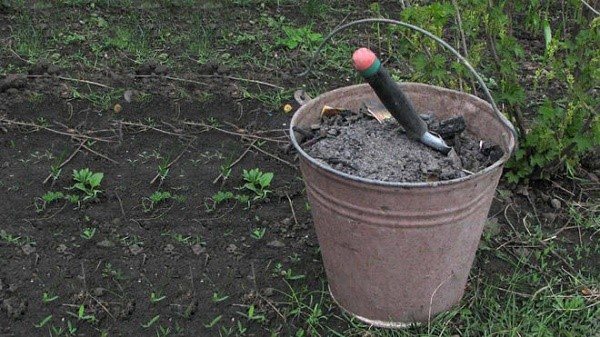

Ash is an excellent fertilizer for grapes, containing many natural nutrients
However, if for some reason you do not have time to dig, then it is allowed to carry out a simple mulching with the selected substance at the base of each vine.
So that in the spring you do not find frozen suckers, and at the end of summer you enjoy a gorgeous harvest, an excellent solution would be to introduce additional nutrients as fertilizers, for example:
- ash (about two handfuls per bush);
- 150 grams of lime per grape bush.
By using only these two fertilizers, you will be able to saturate the vine:
- manganese;
- copper;
- selenium;
- molybdenum;
- calcium;
- boron;
- zinc;
- sulfur and other useful substances necessary for the grapes to gain strength to fight the cold.
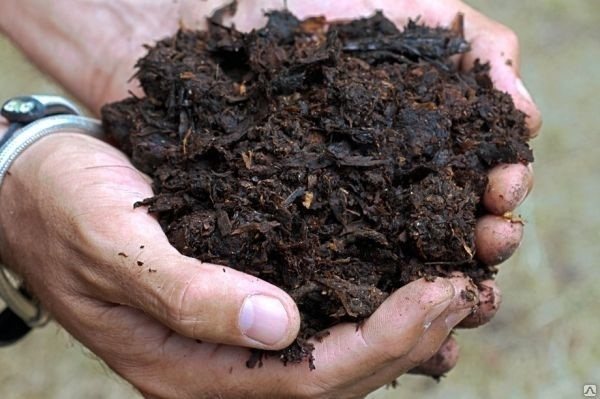

Manure contains almost all the elements that grapes need.
If you are an avid winegrower and adore juicy berries taken from the vines and all the products made from them at home, then it is better not to dwell on the above methods of "feeding" the vines, but to add to the list of fertilizers also compositions containing:
- phosphorus;
- potassium.
Most often, gardeners prefer the following fertilizers:
- superphosphate;
- potassium sulfate.
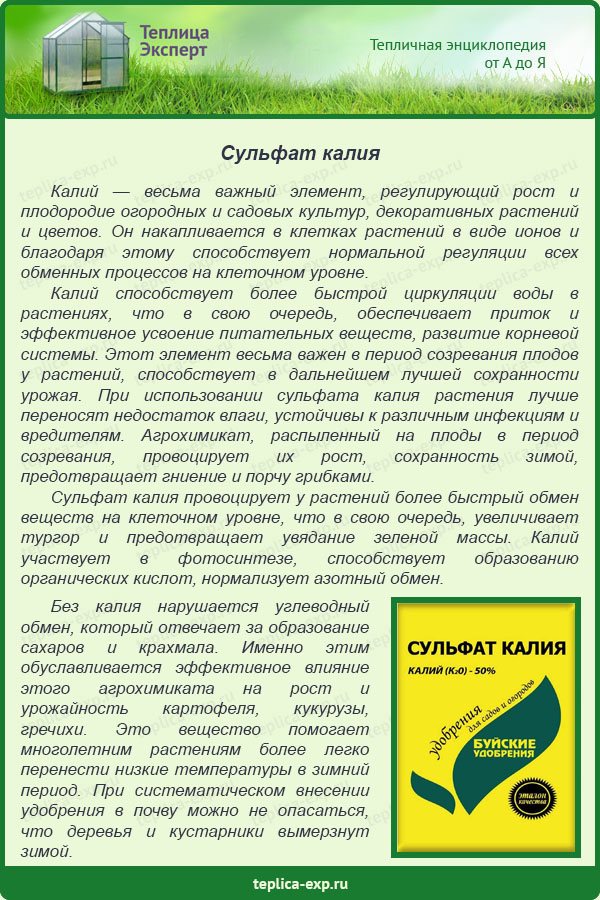

Potassium sulphate
The fertilizers listed above are sold in every shop for gardeners and gardeners. They are realized in the form of granules. So, for 1 square meter of the area planted with vines, it will be necessary to use about 25 grams of each fertilizer.
In addition, it will not be superfluous to shed the area planted with vines with fertilizers in the form of a liquid, consisting of:
- water;
- 20 grams of superphosphate extract;
- 10 grams of potassium salt.
The watering depth should be approximately 20 centimeters.
If the soil on which the grapes grow has been depleted for years and has not been fertilized in any way, it will be very useful to add to the specified extract:
- boric acid in an amount equal to 2.5 grams;
- zinc, in the form of 2 grams of the specified substance;
- ammonium molybdate, 5 grams;
- manganese sulfate, 2.5 grams.
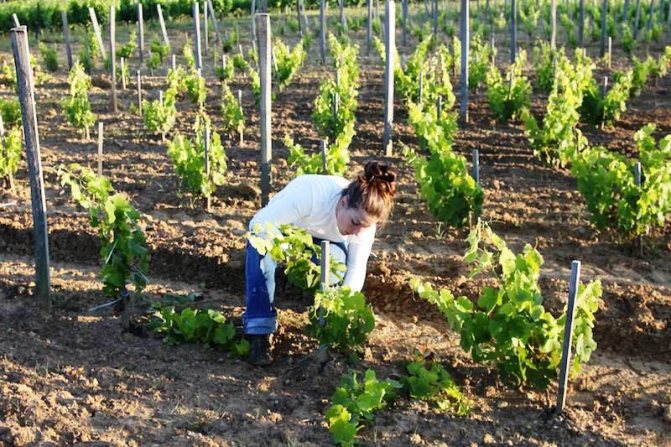

Digging the soil around the vine is necessary to mix all the fertilizers added to it into the soil.
Fertilizing grapes using the methods described above is not necessary every year, but only once every about three years. If you planted the plant the first year this spring, and you fed it as needed, you can leave the vine alone for the next three to four years.
Superphosphate prices
superphosphate
Winter grape pruning
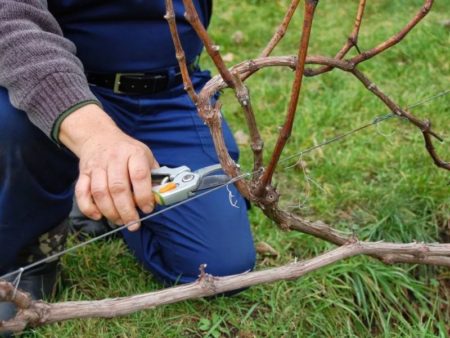

The key point of caring for grapes in the fall is pruning for the winter, its task is to rejuvenate the bush to maintain high yields, cleanse damaged areas and thin out the shoots, reducing the risk of diseases. It is optimal to carry out the procedure in two passes.
Pre-cut
It is carried out in September, when the deciduous cover is still on the bushes. The instruction for the first autumn pruning looks like this:
- Damaged and dry vines should be removed.
- Cut off the growth from the main trunks that has reached 60 cm in height.
- Shoots that have grown above 30 cm from the ground should be shortened by 15% of the length.
- Cut the stepchildren to 2 leaves.
Places of cuts must be treated with 3% hydrogen peroxide or a strong solution of potassium permanganate (concentration of about 50 g per 1 liter of water). After the cuts are dry, cover them with garden pitch.
Basic trimming
The procedure must be performed 2-3 weeks after the leaves fall, when the movement of the juices in the vines has already stopped, but before serious frosts.
The sequence of actions for trimming:
- On last year's replacement knot, you need to remove the vine that has fruited in the current season, cutting it as low as possible.
- The shoot from the outside (lower) of the fruit link should be shortened to the level of 3 buds - a new replacement knot will form from it.
- Of the shoots on the inside, 1-2 should be left on the fruit arrow, pruning to about 6-10 buds. The exact number of the eyes that need to be left can be determined by the diameter of the shoot, adding 1 or 2 to its value, and for varieties with small bunches (less than 0.5 kg) - 3-5. The resulting number will be the "number" of the eye on the fruit arrow, over which the cut should be made.
- All hemp must be processed according to the standard scheme: first with potassium permanganate or peroxide, and then with garden pitch.
Pruning grape vines
First you need to prune the vineyard.You need to start work after yellowing and falling leaves. If there are dried yellow leaves on the vine, but they do not fly around, you can cut them off yourself. At this time, the flow of sap in the vine stops.
The question often arises, is it possible to do without cropping? No, without pruning, the grapes will weaken, lose a lot of nutrients, and this will affect the future harvest, and can ruin it during the long winter.
Pruning is carried out observing the following rules:
- Only healthy vines should be left on the bush, the thickness of which is no more than 1.2 cm.
- Large and thick branches must be removed, since they practically do not yield a crop, consuming a large amount of nutrients.
- Pruning is carried out closer to the trunk, leaving 6-10 buds on the fruiting branch, 4 buds are left on the shoots of old vines.
- All damaged and diseased branches must be removed.
- All cuts are made in such a way that they are facing the inside of the plant. It is necessary to remove all arrows that will not bear fruit.
- After cutting off unnecessary branches, the cuts must be treated with antifungal drugs.
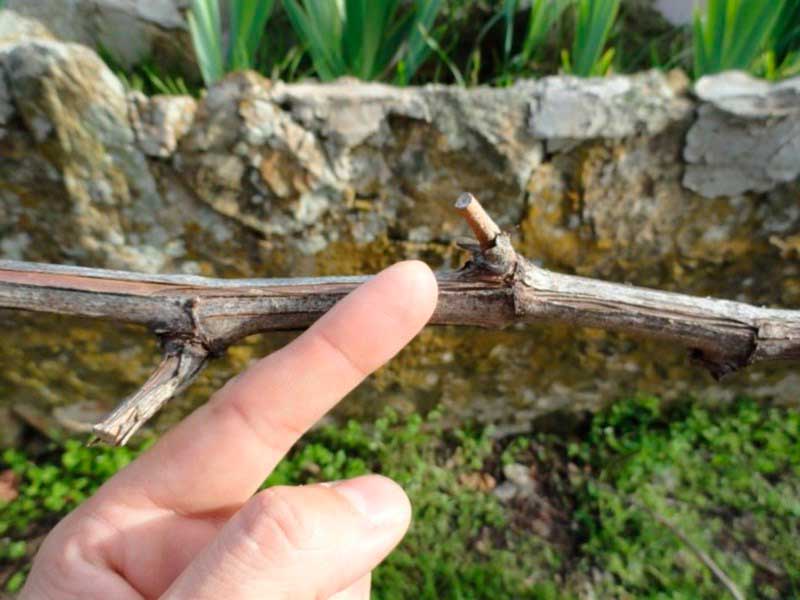

Catarovka roots
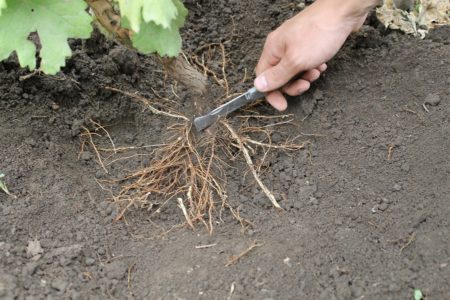

Simultaneously with the preliminary pruning of the bush (in September), you can also prune the roots, called catarovka. Small (dew) roots located in the upper layers of the soil are subject to removal. It is this part of the root system that primarily suffers from freezing of the soil in winter or drying out in dry summers and is the least resistant to damage by grape soil aphids. Decay of small roots can spread to the main root.
Catarovka is a must if there is no opportunity to take care of the grapes regularly. If the bush is provided with constant supervision, root removal can be carried out at will as a safety net.
- Loosen and remove a layer of soil 20 cm thick from the trunk circle.
- Cut off the dew roots near the trunk without leaving any stumps.
- If the plant is adult, thickened roots may also be located in this layer. Their pruning should be carried out gradually over 2-3 years, that is, you need to remove 30-40% of the processes at a time.
- Disinfect the cut sites with a solution of copper sulfate (3%) or boric acid (1%).
- Let dry.
- Optionally, you can wrap the root with foil, but do not tighten it tightly. Reception will postpone the next catarovka procedure for 2-3 years.
- Return soil to the trunk circle.
Types of vine pruning
In total, there are three types of pruning for the vineyard, and they replace each other throughout the life of the vine. And in order to answer the question of how to properly cut grape bushes for the winter, you must first determine the age of the bushes. It is on this that the type of pruning that should be carried out at the moment depends.
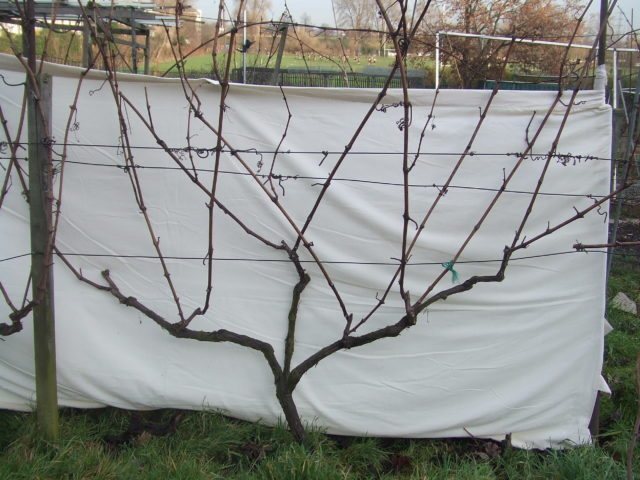

First view Is formative pruning. It is carried out in the 1-3 year of the plant's life. The meaning of its implementation, as the name implies, is in the formation of the shape of the future adult plant. By removing all the weak and excess shoots from the plant, the grower helps the better development of the root system and the establishment of growth vigor for the young bush.
Second view pruning - annual, it is she who is called upon to maintain the potential of the plant for many years. It is made for all mature vines over four years old.
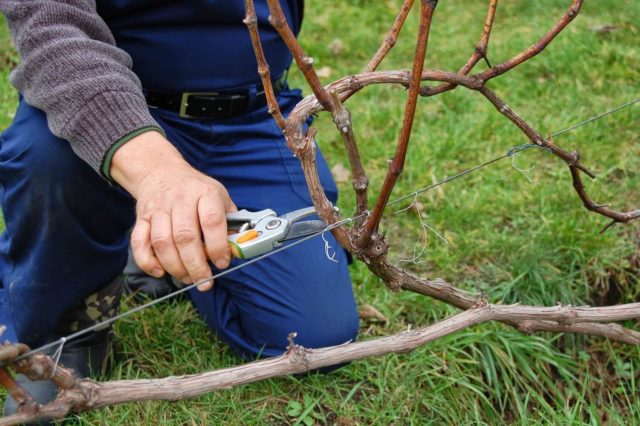

AND third view pruning - rejuvenation of the bushes. That is, the removal of very old sleeves. This pruning is carried out on mature bushes, the wood of which becomes rotten or the sleeves of which are too far from the head of the bush, which disrupts the planned formation of the given plant.
Disease and pest control
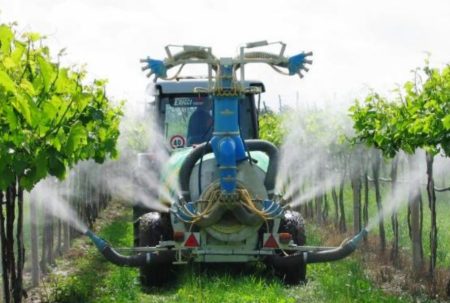

The treatment of the bush against pests and diseases should be carried out immediately after harvest. It is necessary to stop the spread of insects or fungi on the vine as soon as possible - this will increase the chances that damaged plants will have time to recover before winter.In addition, many pests pass into the state of larvae by winter, becoming invulnerable to some of the drugs.
In the case of autumn processing, the use of "chemistry" is justified, which is safe for the next year's harvest, but more effective than biological and folk remedies.
- Depending on the type of pests, insecticides and acaricides should be used - "Actellik", "Oksikhom", "Dimethoat" and others.
- Against the fungus, it is necessary to process it with 5% iron sulfate, and in October, after the leaves have fallen off and pruned, spray it with a 3% solution of copper sulfate.
- In addition to these measures, you can use biological products ("Fitosporin", "Glyocladin", "Gamair", "Trichodermin"), but you should pay attention to the air temperature required to maintain the working properties of the product.
If the treatment is of a preventive nature, the following scheme is recommended:
- After harvesting, treat pests with a lime solution. To do this, 1 kg of quicklime must be poured with 3 liters of water and, after waiting for the end of the reaction, pour 7 liters of water into the solution.
- After the leaves fall, perform a deep digging of the soil to destroy the myceliums and destroy the larvae wintering in the soil.
- In the first half of October, spray with a solution of 10 tablespoons of salt and 5 tablespoons of soda in a bucket of water.
- After pruning, bend the vines to the ground, preparing them for shelter.
- Shortly before warming the bush for the winter, spray with 3% iron sulfate.
In this case, in the spring, after cleaning the shelter, it is necessary to treat the bushes with a 1% solution of copper sulfate. Do not forget that you need to spray not only the vine, but also the soil in the near-stem circle.
What work needs to be done in the fall
Grapes in the fall need the following manipulations:
- correct moistening of the culture;
- treatment against parasites and defects;
- pruning;
- top dressing and soil preparation;
- shelter for the winter.
In addition, in some cases, it is in the fall that the plant is transplanted to a new place.
Each of the above points plays an important role in the full development of the grapes, so let's take a closer look at each stage.
We start with watering
After harvesting, the first thing a summer resident needs to do is to organize competent watering of the grapes in the fall. Do not forget that this crop, as well as other plant varieties, needs good moisture immediately after the crop is harvested. But keep in mind: water should be poured in moderation, otherwise the root system may begin to rot.
Important: If your grapes grow on sandy soils, then the amount of water should be many times greater, in contrast to black soil or heavy clay soil. In this case, humidification is performed less often, but in greater quantities.
The timing for watering in each region is different. But in general, most summer residents claim that moisture in October will be most acceptable for almost all regions. And the last thing: after good watering, do not forget to loosen the soil so that it does not crust over in the future.
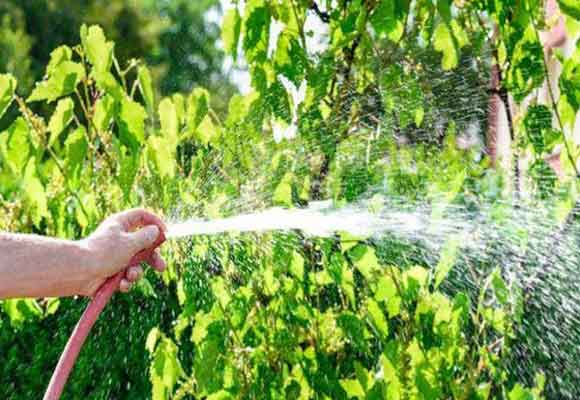

We feed the bushes competently
After our vineyard is generously hydrated, we move on to the second stage of autumn work: fertilizing the grapes. During this period, the pagons weakened and require recharging in the form of top dressing. It is worth highlighting here that fertilizers are very important for the shrub, since with their help the culture gains strength for the upcoming wintering and for laying the potential for fertility next year.
Important: Top dressing is the most important stage of all autumn care. And it is on how you feed the plant correctly that its vital activity in the next year depends.
As a rule, you do not need to dig up the soil around the shrub, you just need to moisten, feed and mulch. These activities will be enough for a proper rest of the grapes in winter.
And one more topical question, how to feed the grapes in the fall.For these purposes, you can use the following substances;
- wood ash;
- mullein as mulch;
- rotted humus;
- compost;
- phosphate or potassium preparations.
Important: It is better to leave nitrogen preparations for spring feeding, since they stimulate the intensive growth of green mass, which is useless for grapes in autumn.
If you do not have the opportunity to purchase potash and phosphate products, organic substances can completely replace them. Moreover, the culture will certainly thank you for such feeding.
Getting started pruning
The importance of pruning grapes in the fall has been mentioned in many articles. However, it is worth repeating that such a manipulation will allow you to get a good harvest next year and heal the plant.
You can start the pruning process only during the period when the culture goes into a state of hibernation. In other words, 2 weeks after the foliage has fallen off. Until this period, it is strictly forbidden to touch the vine, since the process of photosynthesis is still taking place in it. And the trimming process is performed as follows:
- first, all diseased, damaged and dry pagons are excised, which are then burned;
- then cut off all excess shoots in order to give the bush the correct shape. At the same time, make sure that the main branches and several replacing pagons remain on the culture;
- the remaining branches are shortened by 1/3, so that with the onset of spring they begin to develop more intensively.
Important: When pruning, try to always leave 3 young pagon trees as backup material. If suddenly, with the onset of spring, you find some of the frozen vines, you will have the opportunity to replace them and not lose your harvest.
When the trimming is done, take out all the cut fragments outside the territory of the site and burn. Well, carefully coat the places of the cuts with a clay mash or crushed activated carbon.
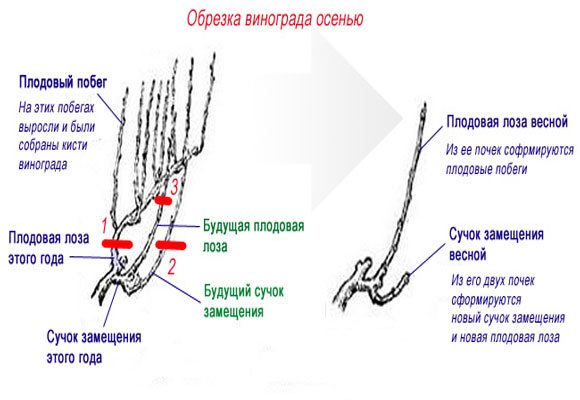

Pre-winter watering
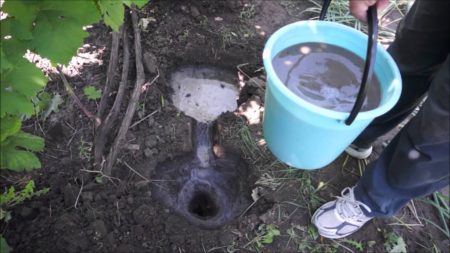

Autumn care of grapes in September in the middle lane assumes continuation of watering as usual, with the exception of periods of rainy weather. Moisture deficiency hinders the preparation of wood for the winter season.
It is especially important to maintain moisture if the grapes grow on sandy or sandy loam soil. In this case, it is necessary to water the vineyard often, in small portions, but plants on clay soil or black soil need more rare but abundant irrigation.
After shedding the leaves and carrying out the main pruning, but before the soil has time to freeze, you need to do water charging. Water should be poured into trenches 10 cm deep around the bush. On average, each plant needs to be given 5 full buckets of water. Old and tall vines will need up to 10 buckets, young plants will need 10-30 liters. Sandy soil requires an increase in the irrigation dose to 6 buckets (relative to the average figure), and clay soil reduces it to 2.5-3 buckets.
List of required tools and materials
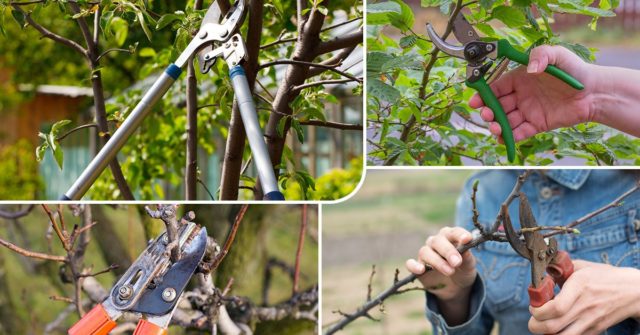

The most common and effective one when working in a vineyard is the usual set of equipment:
- Pruner, which is necessary, especially in the first years of plant life. It easily cuts thin rods, leaving the most even wound surface.
- Hacksaw or reinforced secateurs. Used for rejuvenating pruning of aged vines.
- Secateurs with two cutting blades. It is used by professionals to obtain even cuts on sleeves with a diameter of 2.0-2.5 centimeters for not old creepers.
- Hacksaw, bow saw for wood. It is used for pruning on old vines of grapes, the trunk thickness of which is 6-10 centimeters.
Shelter vines for winter
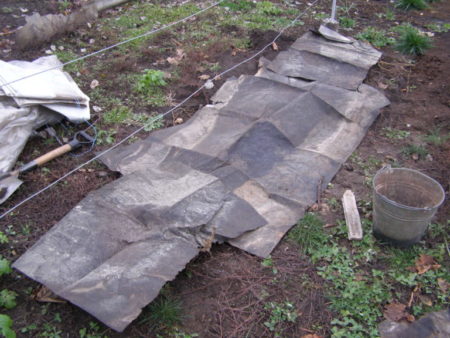

Cover the grapes until the temperature reaches -5 ° C. Bending the vine to the ground should be even earlier in order to have time before the first frost. Frozen wood loses its flexibility, so the vine can crack when laid.
In case of overheating, the root system of the bushes can dry out.It is advisable to first make a light shelter, and later strengthen it, another option is to remove the cover during periods of autumn warming. In regions with snowless winters, a denser shelter is required, but the material must be breathable - lack of ventilation will cause condensation, which is fraught with the appearance of fungi and mold.
Shelter of an adult bush
The vines need to be untied from the supports and bent to the ground, preferably fastened with hooks. From above, they should be covered with spruce or pine branches. Lapnik is considered the best cover for grapes, as it traps a layer of snow and does not impede the access of air to the vine.
Shelter of seedlings and plants of the first year
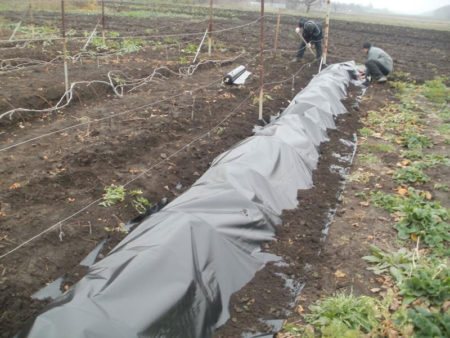

It is necessary to insulate the bushes planted last spring or on the eve of winter more carefully - it is recommended to dig in the shoots. To do this, furrows about 30 cm deep should be dug around the bush. The shoots, previously tied, must be carefully placed in a trench, trying not to damage, and covered with three layers on top (about 10 cm each): soil, humus and another layer of soil.
How and how to cover grapes
The most important thing is that you can cover grapes only after the foliage has completely fallen off and the harvest has been collected. In no case should this be done after the rain, otherwise the vine will begin to flutter, crack and will surely die. There is also a risk of the growth of fungi and bacteria.
In the central and northern regions of Russia, the base of the trunk is sprinkled with earth or snow, regardless of the winter hardiness of the variety. Such a shelter is called partial and protects the roots from frost. At temperatures below -12 degrees, the entire bushes are covered with tarpaulin, slate, agrofibre or other means. On sunnier and warmer days, ventilation holes are made so that the kidneys do not wake up ahead of time. It is ideal to maintain a constant temperature.
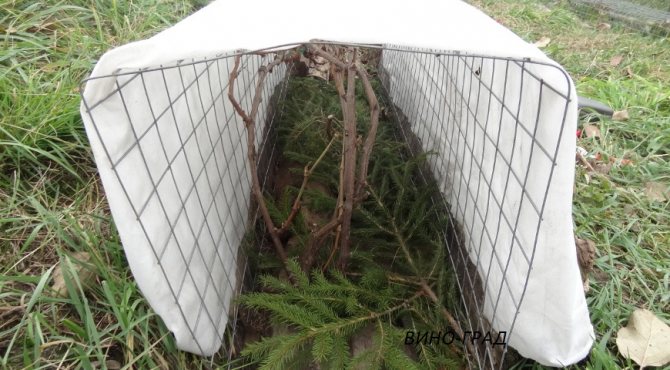

Young shoots are bent to the ground, fixed with a stone or staples and also sprinkled with straw, spruce branches, earth or sawdust. It will be correct to lay vines on slate, boards, a layer of sawdust or fallen leaves, so that the branches do not touch the ground and do not collect moisture. The bark on young bushes is still thin and cannot withstand sub-zero temperatures. For plants weakened by diseases or after abundant fruiting, grapes are covered in the same way.
There are many ways to hide, and you need to choose the one that is suitable for the climate, frost resistance of grapes and improvised means. Also, study the pros and cons of each method and be sure to find out the temperature resistance of your vineyard to frost.
In the southern regions, frost-resistant grapes are not sheltered for the winter, since the temperature rarely drops below -15 degrees.
Shelter in the snow
Of course, this method is suitable for the northern and central regions, where snow lies throughout the winter and falls in sufficient quantities. This is a natural and free protection for bushes from frost, but not suitable for young seedlings. The branches are bent to the ground on a layer of straw or roofing material so that the vine does not melt when the snow thaws.
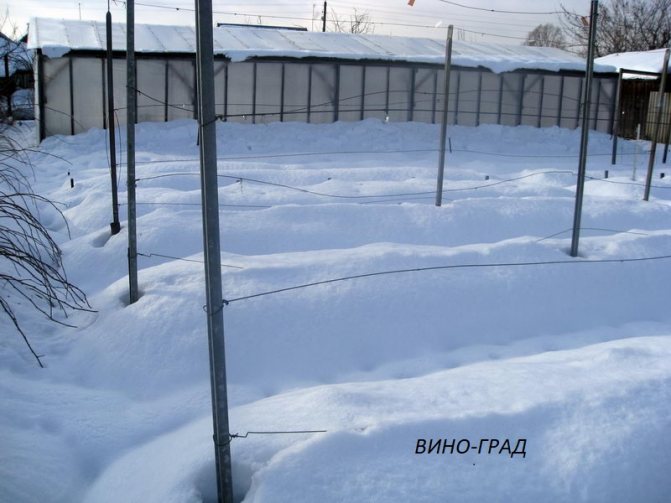

Non-covering varieties in 30-degree frosts can be simply laid in bunches on the ground, pressed with brackets and covered with snow with a layer of 20 to 50 cm. The snow layer must be tamped so that the wind does not spread it.
The easiest way to calculate the required thickness of the snow cover is according to the following scheme: 1 cm of snow keeps the temperature under cover by 1 degree.
If a thaw has passed in the middle of winter or at the beginning of spring, and the snow has melted, re-cover with dry earth, spruce branches, mulch, straw or other means. This will protect the bushes from repeated frost. Plus, when the warmth comes, in spring, the snow will melt by itself, and there is no need to remove it.
Shelter by the ground
Ground cover for the winter is a cheap, quick and reliable way to protect bushes from frost. Before you start making earth mounds, you need to huddle the ground, being careful not to damage the roots of the plant.The ground should not be excessively wet, so as not to beguiled by the eyes, but too dry can quickly absorb moisture, ideally, if it is slightly damp, so it will not let the cold through.
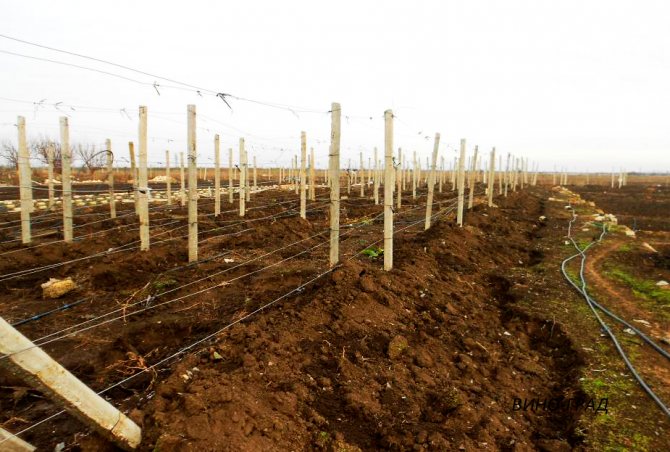

If there are a lot of grape bushes, and the site is very large, then it is enough just to bend and fix the vines to the ground, and fill the earthen hills with a radius of 30 to 50 cm on top of the bush. The area depends on the age of the bush - the older it is, the greater the radius of the embankment so that the root system is completely protected from frost.
In the north, where freezing temperatures in winter can drop even below 50 degrees below zero, a multi-layer shelter is practiced:
- A layer of 15-20 cm of earth,
- then a layer of 10-15 cm from dry leaves,
- another layer of earth,
- at the end, slate, roofing material or film is placed on the formed hill.
If the grapes grow on a trellis, the vine is untied, tied into fascines, laid on the ground and pinned with staples. The earthen embankment is made continuously along the entire row of the trellis. Depressions in the form of trenches along the edges of the row threaten with the fact that when the snow thaws, moisture will accumulate in them, which threatens to freeze and even rot the roots.
If funds permit, it would be ideal to first wrap the vines in any breathable heat-insulating material, and only then make an earthen embankment. So that the bushes do not cheat from contact with the ground, you can make a flooring from fallen dry leaves. The height of the earthen hill is up to 50 cm and is done in stages with a decrease in the air temperature.
The beginning of work - before the onset of the first cold weather, so that the soil does not freeze. Suitable for regions where there is little snow, but if snow falls on top of such an earthen flooring, the shelter will be more reliable. Disadvantage - when digging out bushes in the spring, branches can be damaged, there is a need to store dry soil somewhere in bags.
Dry shelter grapes
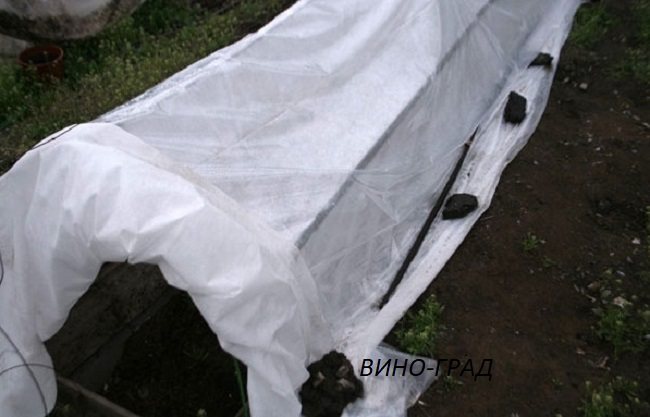

Dry shelter means sheltering grapes for the winter with improvised means: slate, roofing material, penoplex, U-shaped or triangular wooden boxes, film, etc. The vines are bent to the ground and clamped with staples, wire arches are installed at a height of 40-50 cm, a film is covered on top.
In order not to create a greenhouse effect, ventilation is done. At frosts below -12-15 degrees, the edges of the film are covered with earth.
Complete shelter of grapes for the winter
Another way: dig a trench to a depth of 15-20 cm and a width of 40-50 cm, lay the vines in bunches and pin them to the ground. Fill the trench with straw, foliage or spruce branches treated from rodents. Cover the top with slate, wooden boxes or roofing felt, fill the cracks with earth so that there are no drafts.
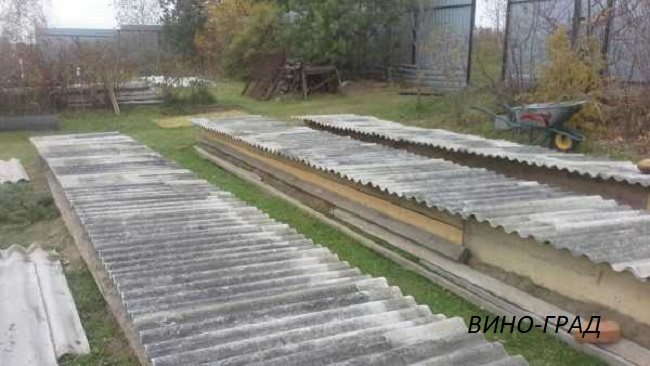

Disadvantages - the process is more time consuming and costly, but at the same time it is reliable. If you do not treat the layer of straw or leaves from rodents, mice will certainly find themselves this warm shelter. Lapnik does not require additional processing - it will effectively protect the bushes from cold, debate and all kinds of pests and fungi.
Reliable shelter of grapes with spruce branches - video
Autumn care problems
The main trouble with grapes during the autumn preparation, which can happen even if all the points of care are followed, is the slowing down of the wood ripening process. Gardeners usually find the problem in October, when it is time to prune the plant and the bush is still green. In this case, you can help the cause by accelerating aging artificially. It is necessary to lay the vine on the ground and cover it with material with good thermal insulation qualities. After the wood has ripened, the bush should be freed from the shelter, carry out the necessary manipulations (pruning, preventive treatment, pre-winter watering) and covered already as planned, for the winter.
It is advisable to take care of stimulating the maturation of wood in advance. In addition to shelter in October, two tricks will help:
- In late August and early September, you should stop watering the grapes.If the weather is hot enough for the plant to suffer without irrigation, moisture can be added along with potassium and phosphorus root dressing.
- In September, you need to carry out unscheduled spraying with fertilizer containing potassium and phosphorus (20-30 g of each substance per 10 liters).
The preparation for winter carried out in the fall, no less than the spring work and maintenance during the season, determines the future volume and quality of the grape harvest. Plants that have safely survived the winter grow quickly, suffer less from diseases and have a sufficient supply of strength for growing fruits.
23
Beginner's cheat sheet
In the fall, they begin to cut the vine only after all the foliage from it has fallen naturally. In different regions, this happens in terms of time in different ways. The pruning itself is carried out in two stages (this is especially true for those bushes that were previously poorly pinned or in which the wood did not have time to ripen).
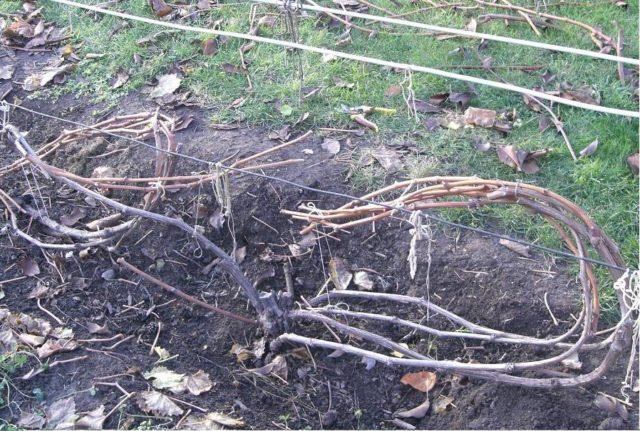

The first stage is preliminary
It is carried out in advance, before the main pruning of the grapes for the winter. A guideline for starting preparation for autumn pruning is bare shoots on a grape vine. As soon as the leaves have fallen, the outside temperature is still above zero and there is still no frost at night, you can cut off all the thin shoots on the grapes, as well as the green parts of the unripe vines and tops.
Advice! After this stage, it is best to immediately carry out preventive treatment of the bushes and soil under the vineyard with a solution of ferrous sulfate.
The second stage is the main one.
It is necessary to start the autumn pruning of grapes no earlier than two to three weeks after the first stage, but preferably before the expected onset of stable subzero temperatures at night. This event is held on a fine day when the air temperature is above zero. After the completion of this stage of pruning, the vines are laid and pinned to the ground for further shelter for the winter period. The very covering of the bushes is carried out after the onset of consistently low night temperatures from -3-5 degrees.
Interesting! The timing of the autumn pruning of grapes does not depend on the region of vine cultivation, they depend on the weather conditions and temperatures established in the growing area in the fall.
The ways
Covered grapes
There are many ways to hide vines for the winter. The most commonly used:
- Shelter by the ground.
- Dry shelter.
- Lapnik.
- Bags.
- Sawdust.
Let's analyze the pros and cons of each of them.
Land
The most natural, easiest and most common way. After carrying out preparatory work on pruning and processing the bushes, they must be pinned to the ground with metal staples or thick wire. In this case, the vine is laid along the entire length along the row, without twisting it so as not to damage it.
Further, the grapes are covered with a layer of soil 20 cm thick. The ground should be dry and light. On top, you can add any material that does not allow moisture to pass through. And in a snowy winter, you can also cover it with an additional layer of snow. This option has its drawbacks: this method does not have the possibility of airing and there is a high probability of damaging the bushes by digging them up in the spring.
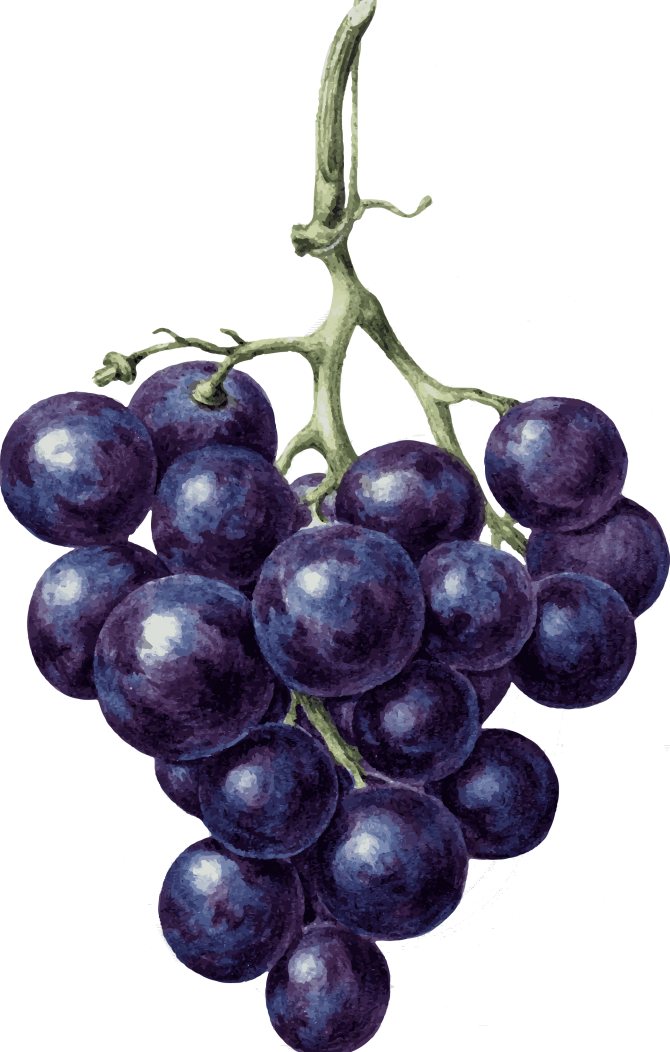

Important! Warming must be carried out before the onset of frost, because it will be almost impossible to cover the bushes with frozen ground.
Dry shelter
The advantage of this method is the complete safety of the bushes and good air ventilation around them.
Make a dry shelter like this:
Shelter grapes for the winter
- Wooden boxes are made.
- The vine is pinned to the ground along the row and covered with boxes.
- Install protection, it must be done close to the soil so that frosty air does not pass to the bushes.
- From above the box is covered with foil.
- For greater protection of non-frost-resistant varieties, a layer of mulch is laid under the boxes.
This method is also quite laborious and not suitable for a large vineyard.
Lapnik
It is necessary to prepare the branches of conifers in advance.Spruce branches 5-10 cm thick are placed on the processed and pinned vine. Boards made of boards are placed on top of it and covered with plastic wrap. The advantages of such a shelter: it protects the vine well from the cold and is easy to remove in the spring.
Bag
Sugar or flour sacks are another great shelter material for grapes for the winter. This is one of the least labor intensive ways to protect the vine and plant roots from frost.
Prepared bushes are covered with bags and sprinkled with earth. For additional protection from moisture, you can cover the top with slate.
Sawdust
Sawdust protects well from frost, is breathable, but they allow moisture to pass through. When wet, sawdust freezes and loses its protective function. Therefore, after covering the grapes with sawdust, it is necessary to lay a waterproof layer on top. Any materials at hand will do: film, linoleum, roofing material, etc.
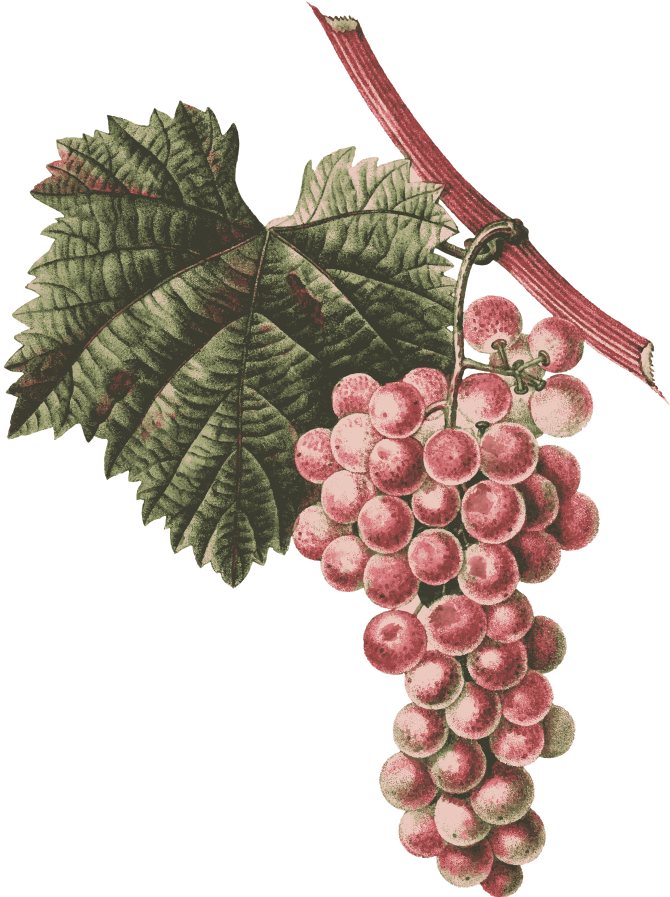

Reference! To protect the bushes from mice, completely cover them with sawdust, leaving no bare vines.
Formation of grape bushes
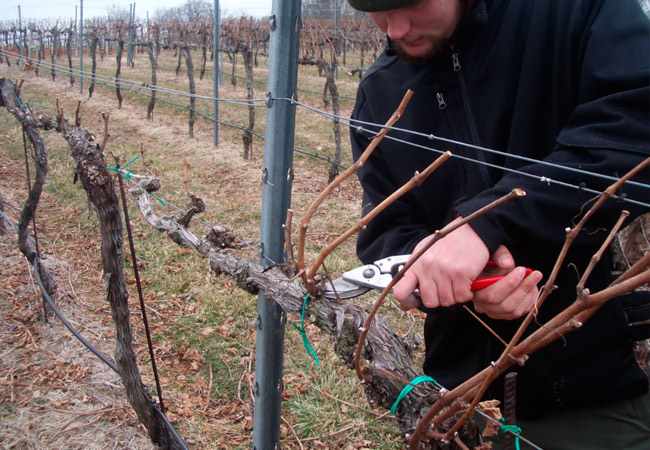

There are many ways to shape the vine. Let us dwell on the simplest and most understandable form - let the shoots grow horizontally, not vertically.
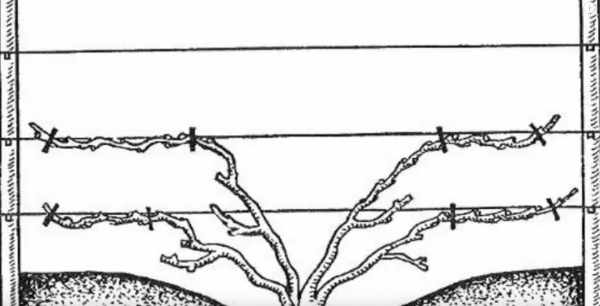

Video - Grapes Pruning a bush
Types of pruning
The methods of pruning grapes differ in how many eyes the vine is shortened. For any particular grape variety, some differences in the pruning procedure are required. Each trimming method involves leaving a certain number of eyes.
Pruning of grapes is carried out by such methods:
- Short. It involves cutting out most of the shoots. As a result, only 2-4 eyes remain on the fruit arrow. Most often, wine grapes are pruned in this way.
- Average. With this method, 6-10 eyes remain on each shoot after the procedure. Pruning is widely practiced in vineyards where table grape varieties are grown.
- Long. The procedure involves leaving more than 8-10 eyes on the shoot. This is how Asian grapes are pruned.
- Mixed (according to Guyot). Includes ideas from short and long cuts. Cut off shoots for replacement (3 eyes). In addition, fruit arrows are left so that the next harvest will be laid on them next year. Through this method, a loop is obtained - a fruit vine, which is cut off after fruiting. Instead of the cut vine, a new fruitful shoot grows from the replacement knot.
Planting grapes
Before planting a seedling, an incision is made on it, checking for damage and vitality. A healthy stalk has a greenish color, while the bark on the entire vine should not change in color. If you press on the kidney, then it will fall off, and when cut, the rudimentary leaves should be visible. If the vine has a pale color and moisture is not observed in it, then such planting material is not suitable.
For the future vineyard, it is necessary to choose a sunny place where the shrubbery will be protected from the winds. At the site, it is determined at what depth the groundwater lies. If the water is too close, it will negatively affect the growth and development of the plant. When planting several bushes is planned, planting should be carried out in one row from north to south, leaving gaps of 2 m between plants, 1 m between rows.
We also recommend reading:
16 of the most popular indoor plants Physalis: description of species and varieties, technology of growing from spruce seeds in landscape design: the best decorative varieties and features of growing Kalanchoe: description of species and features of care at home
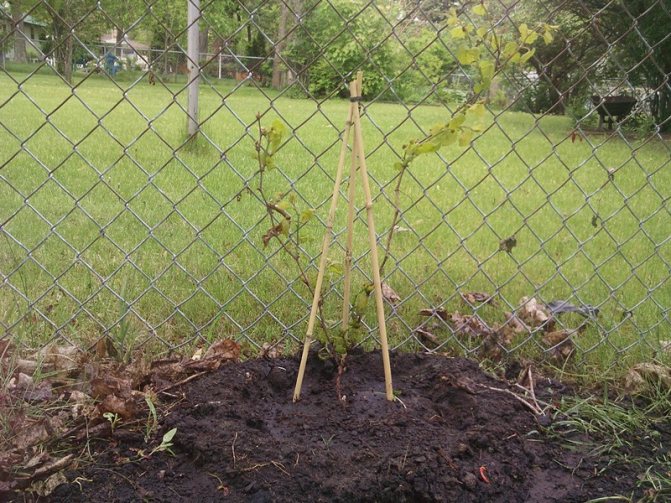

Particular attention should be paid to the preparation of the landing pit. The hole is similar in diameter to a hole for a fruit tree, and this factor is especially important in areas with poor soil. After preparing the pit, about 2-3 buckets are filled with humus at the bottom.If the soil is predominantly clay, then 2 buckets of rubble are poured onto the bottom of the hole, which will act as drainage and ensure the air permeability of the soil. A layer of wood ash 400 g and phosphorus fertilizers 200 g are added as nutrients. After that, all components are well mixed with a shovel with the soil in the pit.
Useful Tips
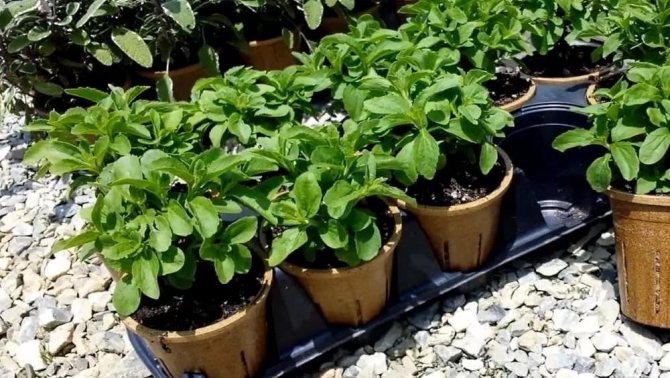

In order for the vine plantations to winter well, correct and timely pruning must be observed: if you prune early or badly, it will not overwinter, it will freeze or freeze, if you are late with pruning, it may dry out.
All trimmed material - bark, shoots, old sleeves - must be removed and burned at a distance, and the soil in the vineyard must be treated from pests and pathogenic microorganisms.
When pruning, the following rules must be observed: if an old sleeve is cut off, at least a small stump must be made, and unnecessary young shoots are completely removed.
Vine care includes pruning before winter with the necessary antiparasitic treatment and subsequent shelter from the cold, taking into account the climatic regional characteristics. Correct pruning is a reliable guarantee of comfortable wintering and good yields in the next season.
Other autumn procedures
Before hiding the grapes, you need to perform other procedures. In the autumn, the catarovka of the root system, watering and processing of the plant is carried out. After that, the plantings are covered for the winter.
Catarovka roots
Katarovka allows you to destroy the roots of grapes that are on the surface of the earth. They do not perform important functions and only take away the strength of the plant.
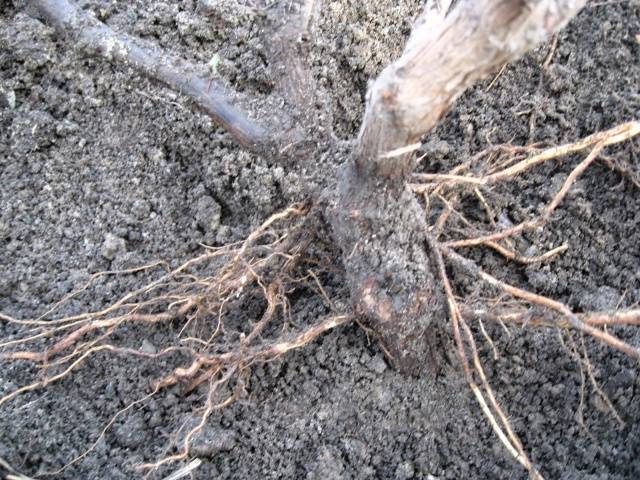

To eliminate excess roots under the stem, a ditch is dug to a depth of 20 cm. The branches located above the main rhizome are removed.
Sections are disinfected with a solution of copper sulfate. Then the hole is covered with sand, and the bush is spud and watered with warm water.
Pest control
A number of preventive measures are taken to protect the vineyard from diseases and pests. Under the bark of the shoots, larvae of pests and fungal spores are often found. Their activity begins in the spring.
The most effective remedy is a solution of copper sulfate. A bucket of water requires 0.1 kg of substance. The consumption of funds is 2 liters for each bush.
For the processing of grapes, special preparations are used: "Topaz", "Ridomil", "Aviksil". To obtain a working solution, they are diluted with water in the ratio indicated in the instructions.
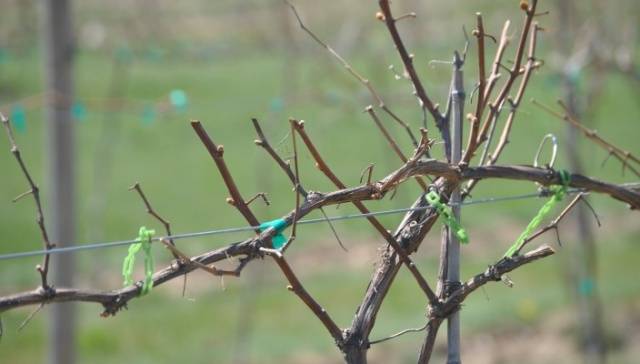

Shelter
After pruning, you need to cover the grapes. Trenches need to be dug along the plantings, after which the vine is tied up and laid in them. From above, the plants are covered with earth with a layer of 15 cm. The soil must be slightly moistened to avoid freezing. This technique is suitable for regions where there are no severe frosts.
Additionally, the vineyard is covered with foil, straw, thick cloth or slate. There should be a snow cover over the grapes, protecting the plants from freezing. To prevent the snow cover from being blown away by the wind, it is necessary to put up shields. In the spring they are harvested, and the earth is thrown away so that the plant can dry out.
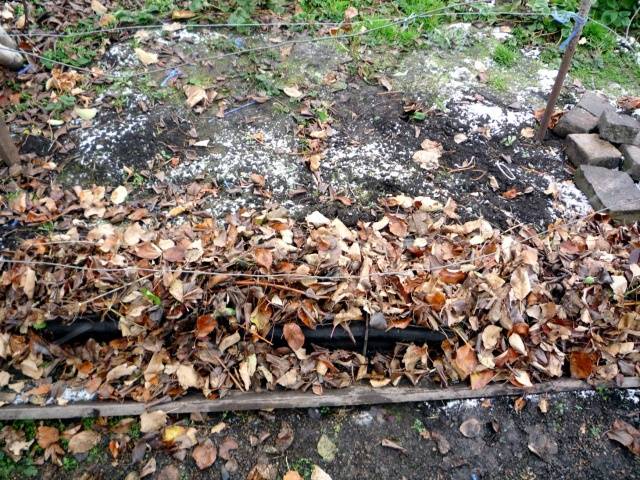

Cutting dates for the lunar calendar 2018
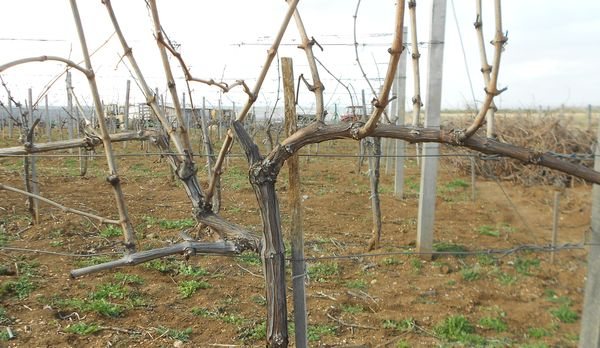

For adherents of pruning grapes according to the Lunar calendar, we inform you that this procedure should be carried out when the Moon is waning - in its 3rd or 4th phase. At this moment, the grape juice moves towards the roots.
When pruning, the grower moves a lot around the site and tramples the soil heavily, which will then affect the deterioration of the air regime of the soil. If the deadlines pass, and the rains do not stop, then put boards under your feet to reduce the compaction of the soil.
Auspicious days when to prune grapes in the fall of the lunar calendar in 2019 are:
- September: 1, 6-7, 15-16, 26-28;
- October: 2-5, 8, 12-13, 25, 29-31;
- November: 4-5, 9-10, 25-28
Pruning is prohibited on the full moon, new moon, on the 23rd lunar day, as well as on the days of increasing Cancer, waning Pisces and Aquarius.
It is undesirable to trim on such days:
- September: 2, 9, 25;
- October: 1, 9, 24;
- November: 1, 7, 23.
Features of the structure and names of parts of the vine


The base of the trunk, which is located underground, is called heel
, roots grow from it.
Stam
- part of the stem up to the first lateral shoot, as in all trees. In grapes, part of the trunk is also underground, ending in the heel.
Head
- a thickening on the main stem, from which lateral shoots extend.
Sleeves (shoulders)
- these are lateral shoots extending from the main stem. And the eyes on them are the same kidneys.
There are terms to remember: fruit arrow and replacement knot.
Fruit arrow
- a long-cut sleeve, on which 8-12 buds are left after trimming.
Replacement knot
- short sleeve, after trimming, 2-4 eyes remain.
Fruit link
- a pair of shoots consisting of a replacement knot and a fruit arrow. We have sorted out all the names, let's move on to the secrets of pruning grapes.
Formation of grapes in the first year


In the spring, the 2 lowest buds are left on the central shoot, the rest is cut off. Of these, 2 shoots are grown, and tie them obliquely in different directions.
In late autumn, when all the leaves fall off, this cannot be done earlier, otherwise the grapes will run out of juice, shortening the shoots. Leave one shoot short, leaving 2 buds, leave the second shoot long, leaving 4 buds. For the winter, remove the vine from the trellis and cover.
What includes
Preparation for the winter period begins, depending on the region, from mid-September to the last days of November. Farmers say that healthy and full-fledged bushes retain their ability to bud up to 80%, and frost-resistant varieties up to 100%. Ideally, the thickness of the vines should be in this case from 6 to 14 mm, and the veneer should be one third of the total section. Find out about the benefits and harms of grape seeds here.
Top dressing
Top dressing for bushes is introduced in several stages and in various ways:
- The first and safest means of plant nutrition is humus. To do this, you can collect rotten leaves mixed with sod in the area of \ u200b \ u200bthe root system, potassium components are added on top.
- Adding lime. Vineyards love calcareous soils, but, unfortunately, this component is quickly washed out, so regular autumn and spring feeding of the bushes is necessary.
- If it is necessary to plant new seedlings in the fall, then the planting pit is first filled with humus, then with sod, and after strengthening the trunk, sprinkle with potassium-molybdenum fertilizers. Usually they are dissolved in 100 ml per 10 liters of liquid.
We suggest you familiarize yourself with: Sauerkraut with green tomatoes for the winter
Before covering a fruit-bearing garden, there is an opinion that it is necessary to water the bushes abundantly, but this is far from the case. The grapes will rot for several months from the abundance of moisture, respectively, rot and deteriorate. Therefore, experienced farmers say that the moisture in the autumn soil is sufficient for the farm to endure the cold. Read about planting grapes in the Moscow region here.
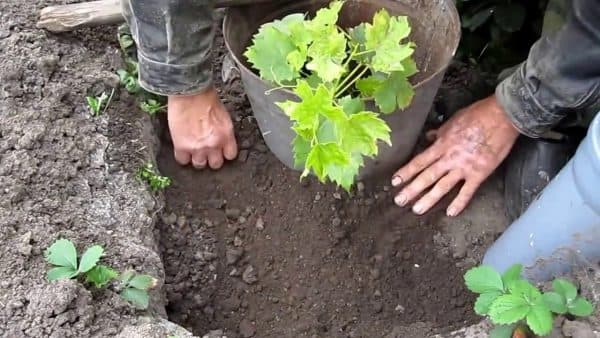

To prevent the cold from penetrating the soil so strongly, it is necessary to increase watering in the fall.
Autumn pruning
Pruning of vines is carried out 2, and in some cases 3 times per year. Each season has its own characteristics:
- In the fall, all elements are examined for diseases, dense branching.
- Usually, the crown is being formed, excess shoots are removed, leaving 5-7 eyes on the vine. In the case of technical varieties, there should be no more than 1-2 bunches on one shoot. This is done to lighten the weight of the branches, increase yields in the future, harvest and subsequent propagation by cuttings in the spring.
The pruning rules are pretty simple:
- the branch is taken carefully, without breaking;
- inspect and, if necessary, cut;
- it is necessary to cut immediately, without breaking or breaking the vine, thereby injuring it.
Sometimes farmers process the cut with soda solution, charcoal or brilliant green. This is done for better corking.
Treatment
Preparation for the winter season cannot be complete without treatment against insects, fungal infections, gray mold and other diseases that plants are prone to. Such solutions are called fungicides. They can be purchased in concentrated or ready-to-use form, and can also be prepared from available products. Learn about Malbec grapes at this link.
It is best for them to process them in the autumn, due to the fact that insects usually hibernate under shelters with the vines, which can significantly harm the fragile branches in the spring.
The following subspecies are distinguished from folk substances that are harmless to fruits:
- Potassium permanganate solution. Dissolve 5 g of potassium permanganate in 10 l of water, this solution and spray the surfaces, including the root part of the trunk.
- Soda solution. 100 g of soda is diluted in a bucket of liquid and the entire bush is sprayed.
Shelter
Pinot Noir and Augustine grapes, like any others, are covered with several options:
- reed shields;
- spruce branches;
- humus;
- dry improvised material;
- film.
There is no one-size-fits-all advice on which of the above is better Each is suitable for a specific locality and a specific grape variety.
As a rule, a mixed version is used: combining dry material with film and spruce branches or humus with reeds. Krasnotop will tell you about the grape variety
It is very good if the winter is snowy, then the snowdrift plays an additional role as a heat curtain. And for additional ventilation, holes are left in the shelter, which are closed when the temperature drops below -20 ° C.
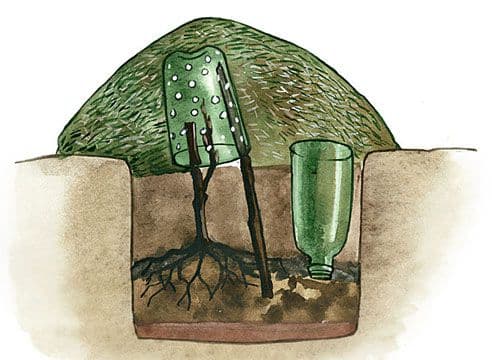

Covering scheme for young grape seedlings.
Timing of top dressing for the vineyard
Fruiting, of course, takes a lot of vitality from the plants, so autumn feeding is recommended while preparing the grapes for winter. This will guarantee a good harvest next year. It will be enough to add a little aqueous solution of potassium and phosphorus fertilizers under each bush: potassium nourishes the grape root, and phosphorus strengthens the immune system.
The soil must be loosened after watering and fertilizing. Organic liquid fertilizers should not be applied; it is best to mulch the soil around the grape trunk with rotted manure mixed with wood ash in winter.
The time and duration of the winter shelter of the wine
Winegrowers are unanimous about how to provide a winter shelter for winegrowing. And yet, what seems to be overkill, here their opinions become completely different. Some winegrowers are convinced that with the slightest hint of lowering the temperature, at once it is necessary to hide the wineyard. The second category of "experts" considers that it is necessary to wait, when the temperature drops to -5 or -6 degrees. As soon as you have set up such a temperature, then it is worth starting work related to the concealment of plants. Wine grants of both the first and the second category provide their own non-flawless aphuments, such as what should be the period of grape hiding.
Fresh articles about garden and vegetable garden
Mallow planting and care in the open field
Transplanting chrysanthemums in the fall to another place
Nivyanik: planting and care in the open field
If the vines of the wine are healthy, they have ripened perfectly on the abundantly given fruits of the grape bushes, it is possible and not to hide them. Wait until the minute stable temperatures are set. It is necessary to make a "quake" of the wine, when the first "hints" of the sea appeared, in the form of the first chills. This will facilitate an increase in their overall freezing capacity.
Common mistakes gardeners make


The main mistakes of novice winegrowers are:
- too early or too late shelter of grapes;
- use of unsuitable materials;
- insufficient or excessive insulation.
With early shelter and excessive insulation, the plant can vanish, and prematurely buds are formed on it. Late shelter and insufficient (or uneven) insulation is fraught with freezing of the vine.
Shelter materials that are in direct contact with the grapes must be natural and properly combined with the top coat. So, the film is able to retain condensate, which requires periodic ventilation. But agrofibre is also not ideal, since it is permeable and can cause decay during thaws, and if frost returns after that, frostbite of the plant.
Proper insulation depends on the region, the grape variety and the availability of scrap materials. If young grapes are well prepared for winter and covered properly, they will thrive and bear fruit.
Processing and spraying grapes before winter
In the fall, it is imperative to carry out preventive and, if necessary, therapeutic spraying of grapes. They are carried out in two stages. Immediately after harvesting, it is necessary to treat the bush with an insecticide to destroy harmful insects and prevent them from settling inside the wood. The choice of such funds is quite large, for example, the well-known "Aktara" copes well with pests. If outbreaks of fungal diseases were observed in the summer, fungicides are used simultaneously with insecticides. If the foliage has not yet fallen, choose mild products, for example, Bordeaux mixture. More effective preparations for treating grapes by spraying in the fall before sheltering for the winter, such as copper sulfate, iron sulfate and urea, are applied only along the bare trunk.
Often, as mild fungicides, it is recommended to use drugs intended for the treatment of fungus in humans, considering that they are safer. As a rule, they have tablet forms, it is almost impossible to dissolve them completely. Accordingly, their effectiveness is extremely low. Also, opponents of chemistry fight the fungus using the following means:
• Soda; • Laundry soap; • Tar soap; • Vinegar; • Potassium permanganate; • Ash solution; • Other substances.
The effectiveness of these funds is minimal, but they will not cause harm either. The only pharmacy remedy that works well when spraying grapes for diseases in the fall is hydrogen peroxide.
In outskirts of Moscow
It is most reliable to protect grapes near Moscow from frost if it is planted correctly. A planting hole measuring 60 * 60 cm with a depth of at least 15 will allow the vine to be insulated according to all the rules. On a dry, sunny day, the sleeves are folded into a ring and placed on the bottom of the hole. Shoots are treated against possible diseases, they leave a pungent-smelling substance from mice - best of all, pieces of carbide. The top is covered with wooden shields or pieces of roofing material. It is useful to cover the resulting shelter in winter with additional snow.
Fruiting bushes keep more complex shelter in winter frosts. Cut grape sleeves are placed on dry boards, in extreme cases, on dry soil. Arcs from temporary greenhouses are installed above the bush. Coniferous spruce branches are laid on top of the arcs. You can use the branches left over from trimming the conifers growing on the site. Coniferous spruce branches can be covered with two layers of spunbond to secure the branches and keep warm.
Instead of arcs, you can put together a box from the boards at hand. It is installed on vines covered with conifers.
conclusions
For successful wintering of grapes, several simple rules are followed:
- Autumn preparation, which includes not only pruning, but also watering, fertilizing, as well as processing against possible fungal infections.
- Shelter in the winter in the Urals, Siberia and other regions. The more thoroughly and better the work is done, the easier the vineyard will endure the cold. Do not forget about ventilation, air exchange in the ridges.
- In the winter period itself, care is reduced to monitoring the condition of the vineyards and making any adjustments to improve the condition.
- After winter, the vine is opened, but they give it a few days or weeks to breathe, get stronger and adapt. After that, the film is finally removed.
We suggest you familiarize yourself: Green tomatoes for the winter in banks - 8 simple recipes
Watering first
Like any fruit crops, grapes need more watering during the ripening period. However, this also cannot be overdone.
Due to excess moisture during the period of high rainfall, the berries on the vine burst, which reduces their taste and attractive appearance.In addition, these berries are no longer stored for a long time, they should be immediately processed and juiced, or left to ferment to obtain wine or grape vinegar.
After harvesting, the grapes are not recommended to be watered often, but, nevertheless, the soil should be well saturated with moisture, for complete saturation of the root system and better preparation of the bush for winter.
The timing and frequency of irrigation are determined by the climate in the region where the vineyards grow, which affects the temperature and humidity of the air, the intensity of the winds, the depth of groundwater and the timing of the onset of frost.
However, wherever the vineyard is planted, in the middle of autumn, it is necessary to abundantly saturate the soil with moisture. Sometimes for this purpose, narrow grooves are equipped so that water penetrates precisely under the roots of the bush, and does not spill around.
After watering, it is advisable to loosen the ground around the bush for better air penetration and retain moisture in it for a longer period. Such measures contribute to the better resistance of grapes to frost.
We advise you to read
- Oidium grapes and control measures
- We study the nuances of care and planting grapes in Siberia. ...
- How to spray grapes after flowering and during the ovary period
- Wine from grapes at home
- Features of growing grapes in the middle lane ...
- Growing grapes from cuttings
- How to plant grapes correctly: tips and practical ...
- When and how to feed grapes?
- How to care for grapes for a good harvest
Wine glasses
When to prune grapes correctly - in summer, fall or spring and why
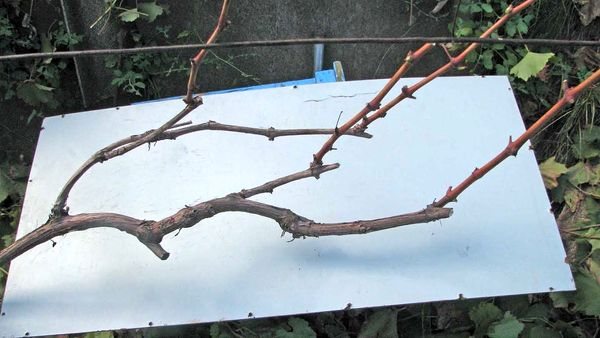

In order to fully understand how and when to start pruning a grape bush in the fall, you need to know the difference between spring pruning and a similar autumn procedure. In addition, natural conditions must be taken into account.
Growers prune the crop in the fall after the leaves have fallen, and in the spring, trying to complete the work before the bud opening phase.
Due to the fact that untreated bushes are difficult to shelter from winter frosts, most vineyard owners carry out this operation in the fall. As usual, varieties that do not require shelter are pruned in the spring.
It is believed that a bush that has not been pruned can endure winter frosts more easily, since such a procedure reduces winter hardiness. But during the autumn pruning of the vine from the wounds remaining after the procedure, the cell sap flows out in a smaller amount than in the spring.
Read also How to salt porcini mushrooms at home
As an exception, it happens that the bushes cut off in the fall suddenly begin to secrete juice from the wounds in the spring. But nothing can be done about these - after a short time, the wounds will heal by themselves.
Optimal time for the autumn procedure
Only after waiting for the final fall of foliage from the crop, you can start pruning. If this work is carried out ahead of time, then the bush will receive less nutrition from the leaves due to its natural outflow from the drying foliage into the roots of the plant. This nutrition may then be lacking for the plant for a successful overwintering.
But it may happen that the tentative period has already approached, and green leaves flaunt on the bushes. Then you need to cut them off with your hands and cut off with a pruner. The beginning of the pruning procedure is planned for the period of time when the first morning frosts occur in your region.
At this time on grape plants the ripening of the vine ends, and the leaves acquire a yellow color. The yellowness of the leaves indicates that they have given nutrients to the plant. Pruning in time should coincide with light freezing of the soil.
The pruning of vines depends on the climate of the growing area and the prevailing weather conditions for a given season of the year.
Works in the post-winter period
In most cases, winter care is reduced to regular inspection of the ridges for damage:
- ventilation control;
- is there too much moisture or dry soil
- whether mice are wound up in the covering material.
Pruning
It is very rare, but some gardeners practice winter pruning. This way of leaving is typical for southern latitudes, where winters are mild and little snow. In this case, pruning of incapacitated branches that can be seen through the film is possible.
In winter, watering is done in extremely rare cases, only with snowless and dry winters. Signs that the plant needs hydration are immediately visible:
- the ground under the bushes cracks;
- spots appear on the branches, a lot of dry, dying branches.
In this case, it is watered not only with clean water, but fertilizers with minerals are added there. Watering is carried out by the method of dispersive irrigation.
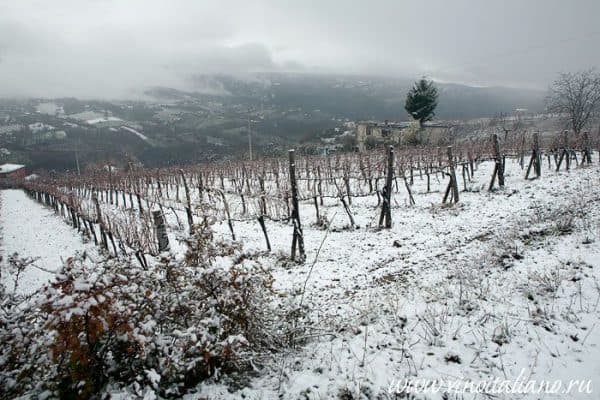

However, in the middle of autumn, you need to water it well - this way you can prepare the plant for the winter period.
After winter, when the night frosts have passed, the vineyards are opened and prepared for the further fruiting season. In addition to the fact that in spring, as well as in autumn, the bushes are pruned, for a successful increase in yield, there are certain rules that are observed when opening the vine. This article will tell you about the reproduction of the Maiden grapes.
How to open
Experienced farmers advise to open most varieties, including Taifi, during the period when the snow has not yet melted. When the first positive indicators appear, the covering material is removed, but a kind of greenhouse is made from the film. It is fixed on the trellis, slightly dripping at the bottom and tucking the polyethylene under the lower slats.
Thus, the vine lies for several days, thawing and spreading the branches. Then, when traces of tying new shoots are noticeable, it is carefully removed and fixed in place.
Only after that, the grapes are pruned and watered.
The nuances of the process depending on the age of the bush
The choice of the method of shelter is also influenced by the age of the grape bush. The younger the vine, the less resistant to low temperatures and the more it needs winter insulation.
Immediately after planting in the fall
To protect the young seedling from the cold, it is insulated with a cloth, straw or waterproof material, and a layer of earth is dropped on top. For these purposes, they often use a plastic bottle or an old bucket and also sprinkle it with earth.
Annual
For annual grapes, the hilling method is most suitable. Depending on the frost resistance of the variety, the bushes are covered with a layer of earth from 15 to 25 cm. In cold regions, they are also additionally covered with a film, which is fixed from the sides with metal pins or earth.
Biennial
Autumn pruning of biennial grapes is an important stage in crown formation. By this time, the bush already has 4-6 vines. In the fall, they are cut off, leaving 2-3 buds on each. This will make it easier to cover the grapes that have not yet matured. The two-year-old grapes are also covered by sprinkling with earth and additionally warming with a film.
Three year old
To cover a three-year-old bush, the branches are tied together in bunches and pinned to the ground with staples. Further, they are insulated in any convenient way.
When to shelter
Often, novice growers mistakenly perceive the recommendations to shelter grapes for the winter after the onset of the first frost, when the temperature exceeds minus five. This contributes to a kind of hardening of the plant, because biochemical processes take place in it, contributing to a better entry into winter. But this indication is correct for an adult already fruiting vine, while young grapes must be preserved and covered before the onset of frost.
In the suburbs, Central lane
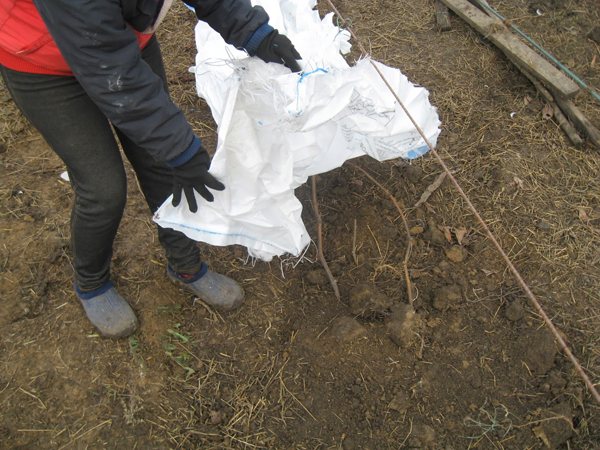

The period for sheltering young grapes is on the eve of the first frost, when the night temperature is already noticeably decreasing. You should not be guided by leaf fall, because the timing of natural defoliation may not coincide with a decrease in temperature: often frosts capture a plant that has not yet lost its leaves.
In the Urals
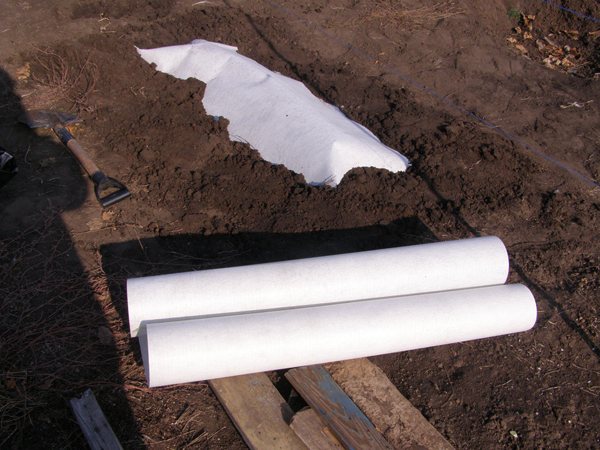

In the Urals, it is necessary to start building thermal protection for young grapes before the first frost, which occurs in this region around the end of October - early November. It should be understood that we are talking mainly about the Southern Urals, and not the Sub-Polar region.
In Siberia
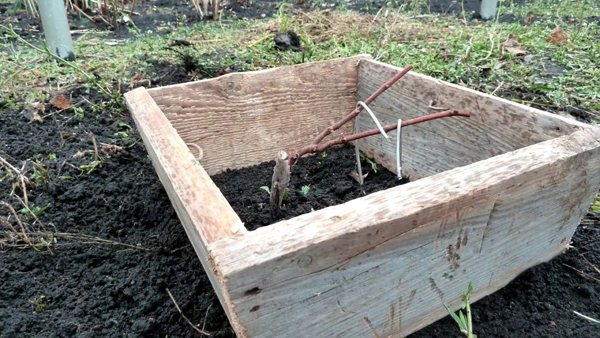

The phased covering of Siberian young grapes begins in September, when the last leaves fall and the average daily temperature does not exceed + 5 ° C, and ends after frosts are established and the temperature is not lower than -5 ° C. If the leaves are in no hurry to fall off, manual defoliation is performed (in other words, the remaining leaves are picked off the grapes by hand).
In the Leningrad region


The humid climate of the Leningrad region dictates its own characteristics of shelter for the winter: they shelter not so much from frost as from a thaw. The frost on the grapes formed at this moment breaks the bark. Therefore, dry lightweight covering structures are being built, although St. Petersburg winegrowers can already boast of non-covering varieties. You need to start covering before a steady cold snap.
Watering and feeding
After harvesting, the vine should be watered only if the summer heat is still outside. If the weather is cool and rainy, watering is not needed until pre-winter preparations begin at the end of October.
Autumn watering should be carried out in a recess specially dug around the grape trunk. Thus, moisture will flow strictly to the roots, without spreading over the garden.
A well-chosen composition of top dressing will provoke the active growth of young shoots: this means that fruiting in the next season will be abundant. But it is necessary to make only water-soluble dressings, since other grapes are not fully capable of assimilating.
So, at the beginning of September, the grapes need to be fed. The following nutrients are used for this:
- superphosphate - 100 grams per bucket of water;
- potassium magnesium - 70 grams per bucket of water.
The components are mixed with water and then poured over the resulting solution of the grapes. If the vine is young, the fertilizer dose should be halved. After two weeks, feeding is repeated.
After pruning is complete, you need to feed the vine again. To make the plant come to its senses faster and activate young growth, add the following components:
- wood ash - 550 g;
- potassium sulfate - 25 grams per bucket.
As additional sources of nutrients, you can use:
- superphosphate;
- potash-phosphorus compositions;
- potassium chloride;
- manure.
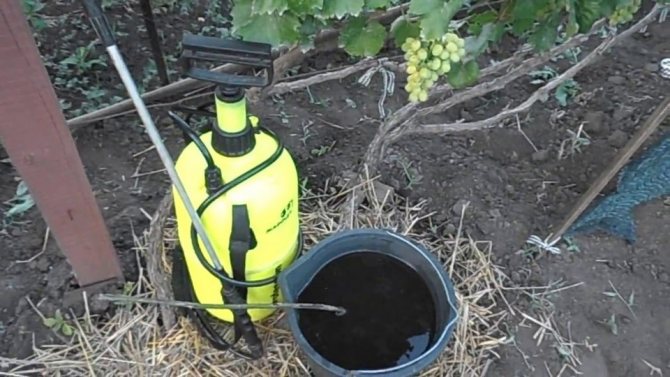

Do not hesitate to feed manure. This organic, inexpensive substance contains valuable minerals and beneficial bacteria that have a beneficial effect on the composition of the soil. It's not a bad idea to use chicken droppings - but it should be bred in high concentration (1:40).
Attention: the introduction of any dressing should be carried out in a root circle with a diameter of 1 meter from the base of the trunk.
If the grapes are young
For a young plant, autumn care will need to be more attentive. It is necessary, among other things, to loosen the soil and remove weeds in the garden. Loosening should be done carefully so that the roots of the plant do not touch. Watering a young vine is necessary even in cool weather, but only if the top layer of the soil dries out.
Autumn pruning is the most important step in caring for any grape variety. The procedure allows for the correct formation of the bush and achieve impressive yields in the next season. In addition, timely pruning has a positive effect on the number of fruits, their taste, and on the health of the vine as a whole.
Autumn pruning work in the vineyard is recommended during the time period from late October to early November. The specific date is determined by the timing of the fall of the foliage: when the colored leaves crumble, you should wait 2-3 weeks and then start pruning. This period is due to the fact that in 2-3 weeks the shoots will have time to be saturated with useful substances.It is undesirable to carry out the procedure too late, since the shoots caught in frost become fragile, brittle, and heal poorly.
First, old and diseased branches are removed - this is the sanitary stage of the procedure. All bio-waste removed from grapes must be burned in pits, and not thrown away: this measure helps to protect the vineyard from the spread of infections and pests.
Try to use only sharp and clean tools, achieve the smoothest possible cuts with a small area. Such sections heal quickly, and clean instrumentation will not lead to infection of the vine.
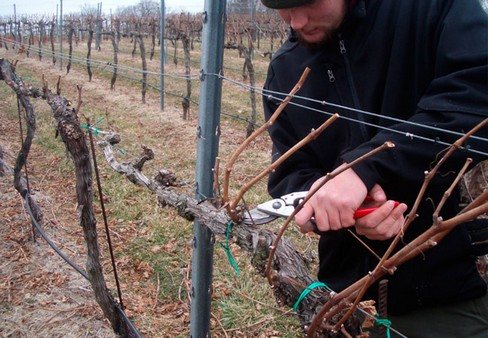

Autumn pruning of grapes can be done in several ways.
In this case, the main part of all shoots is removed, leaving only "stumps" of 2-4 eyes on the vine. This option is ideal for a bush in need of radical rejuvenation.
Up to eight eyes are left on the shoots, no more. Medium pruning is used when it is necessary to obtain a frost-resistant vine with healthy and fruitful shoots.
In this case, up to 15 eyes are left on the shoot. Long pruning is used when the vine does not need rejuvenation and is completely healthy.
In this case, for some shoots, short pruning is used, and for some, long pruning. This method is universal and is most often used in amateur grape cultivation. Mixed pruning allows for an individual approach to the shoots: as a result, the taste of the fruit becomes better, and their quantity and weight increase
Pruning depending on the age of the grapes
First year
The vine is not pruned in the first year of its life. An exception is made only if the bush has defects, damage or curvature. In this case, cropping will be aimed at eliminating the flaw.
Second year
In the second year, the shoots of the vine are cut off almost completely in the fall. Only two of the largest and strongest, the most promising are left. Pruning is carried out so that hemp remains from the shoots: otherwise, the stem may burst when it dries.
Third and subsequent years
In the fall of the third and subsequent years, weak and damaged grape shoots are pruned. Old branches are also subject to removal: it is known that only a young vine bears fruit well.
- Try to cut the shoots from the inside of the vine: the places of the cuts will heal more easily, and the shrub will be spared from thickening.
- The larger and thicker the shoot, the longer it is left. A young, flexible vine is pruned thoroughly.
- If the grape is a late ripening variety, and its branches bend under the weight of not yet fully ripe bunches, it is better to cut off the extra bunches. This will help the bush to direct all its forces towards the complete ripening of the remaining bunches.
Read also: Adler grapes - description of the variety with photos, reviews, planting and care
As all professional growers say, without competent pruning of good yields, there is nothing to expect from the vine. In addition to pruning, in the fall, a fragment of shoots is also carried out: the last procedure is applied to old and dry branches.
What is and why is katarovka needed?
Catarovka of grape roots is the removal of small roots located at a depth of 20-25 cm from the surface, such roots are also called dew roots. Since they are located close to the surface of the earth, they take moisture and food from the surface layer. With a prolonged absence of watering and precipitation, dew roots can dry out.
In winter, even with light frosts, when the soil freezes at least up to t -5 °, there is a danger of freezing. In addition, it is the dew roots that are most susceptible to infection with phylloxera (very small grape aphids that live and feed on the roots).
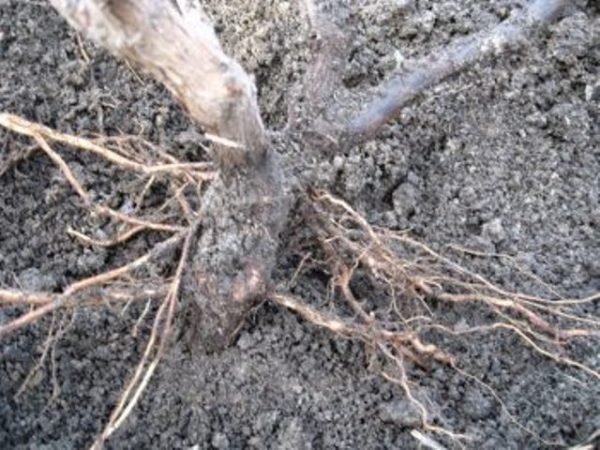

Catarovka grapes in autumn
To avoid all these troubles, catarovka is carried out: small roots are removed and this contributes to the development and deepening of the calcaneal roots (deep).But this process is quite laborious and dangerous for grapes, so you need to cut the roots with great care. Catarovka of the roots of young plants is carried out 2 times a year - in June and August. If the bush is not young, in addition to small dew roots, it can also have rather thickened ones. Their cutting should be done with extreme care and gradually - over 2-3 years.
Technology: the soil around the trunk is dug to the desired depth. The roots are cut with a sharp pruner without leaving knots. Sections can be disinfected with 3% copper sulphate or 1% boric acid solution, dried and covered with soil again.
In order not to repeat this procedure every year, the cut part is wrapped with a film in 2-3 layers (weakly, with a margin of 3-5 cm), or a plastic corrugated hose cut along the length, tied with natural twine and only then covered with earth.
For such plantings, it is very important that the grapes have a developed, deeply rooted root. On personal plots, it is not necessary to carry out this event, since timely feeding, watering and sheltering the bushes for the winter is possible.
Read also: Radiant Kishmish grape: description of the variety, cultivation, care and reviews
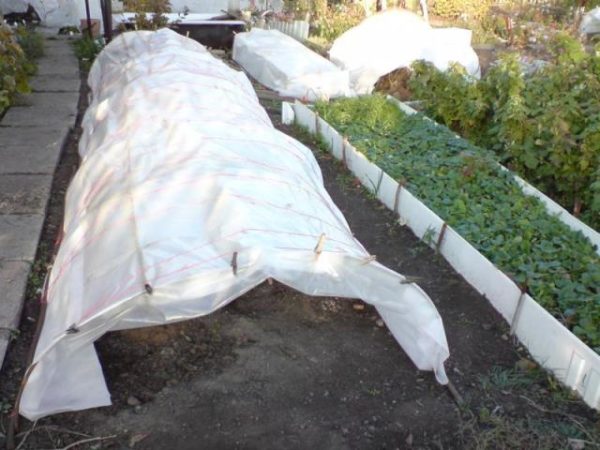

Shelter of the vine for the winter with ducking
Formation of grapes in the third year
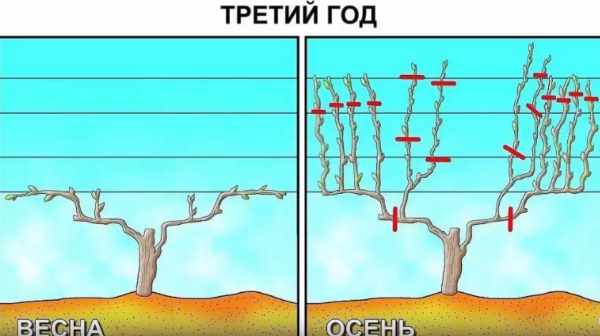

In the spring, after the frost has passed, the shelter is removed from the vine. Tie long fruit arrows to the bottom wire of the trellis horizontally, with the tops in opposite directions.
Replacement knots
let it grow vertically. During the summer, stems will grow from all the buds. At the beginning of August, carry out chasing - cutting the stems by 10-20 cm. This will increase the quality and quantity of berries.
Do not mint before August, otherwise a lot of shoots will appear on the vine.
In autumn
, after the fall of leaves, cut off the last 4 vertical shoots with a part of the sleeve that have borne fruit.
As a result, one link with two vertical shoots will remain on each shoulder. Prune them in the same way as in the second year. Cut off the shoot closest to the center, leaving 2 buds, leaving 4 buds for the distant ones.


All subsequent years of growth of the grape bush, pruning is the same as in the third year.
Attention: for greater reliability and stock, more buds can be left on the shoots, but no more than 10 on each. This is done in case of frost damage.
For example, the optimal number is 3 buds on replacement knots and 6-7 buds on fruit arrows. In the spring, if all the kidneys survived, the extra ones can be cut off.
How to properly spray crops
Immediately after harvesting the last harvest, you need to start treating the grapes with chemical solutions. There is no need to delay with this, since pests and diseases can cause serious damage to the vines in a very short time. Processing of early varieties should be carried out without waiting for the end of the grape harvest from later varieties. Correct spraying is carried out in calm dry weather, when rain is not even expected.
Treatment with copper and iron vitriol is recognized as the most effective. If there are no traces of a fungal infection on the grapes, the spraying can be divided: in the fall, treat it with copper sulfate (dissolve 100 g of powder in half a liter of warm water, and then add the solution to 10 liters with cold water and spray from a spray bottle), and in early spring, before budding, process with iron sulfate.
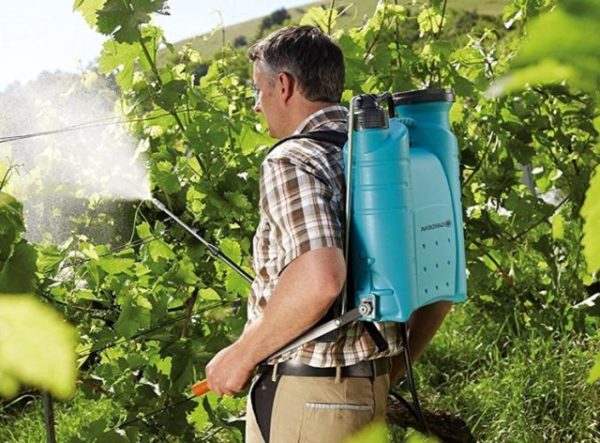

Processing grapes from hit in the fall
ZhK very effectively fights against all types of fungal diseases and saturates the plant with all the necessary microelements. Thus, the vine receives protection and foliar feeding at the same time. For the solution, it is necessary to dissolve 300 g of ferrous sulfate in 10 liters of water and abundantly spray the vine and soil around the trunk.
If traces of fungal infections in the bushes are found in the fall, the treatment with copper and iron sulfate is carried out simultaneously.
There is another option that experts recommend: the autumn processing on the leaves is carried out with a soda-salt solution - for 10 liters of water 5 tablespoons of salt + 5 tablespoons of soda. It is necessary to spray 3-4 times in the beginning - mid-October, very carefully processing each leaf, vine and soil around the plant. In this case, the treatment with copper and / or iron sulfate can be carried out immediately before the vine is sheltered for the winter.
Preparing for shelter
Preparing young grapes for shelter includes such phases as:
- watering;
- pruning;
- top dressing;
- antiparasitic treatment and prevention of plant diseases.
The technique of carrying out these stages of preparation and the amount of work depend on the age of the grapes and the climatic characteristics of the region.
Cropping - is it necessary?
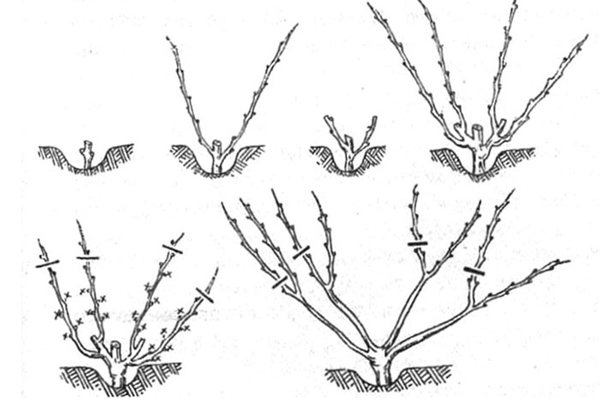

In general, autumn pruning for grapes is very desirable, this procedure:
- Promotes plant health (sanitizing or sanitary pruning).
- Makes the bushes more compact, which facilitates the covering process itself and improves the quality of overwintering (forming pruning).
- Allows you to avoid the loss of juice, in contrast to spring pruning.
Young vine runs the risk of freezing in winter, so as soon as leaf fall ends, it is cut off. But this does not apply to first-year grapes, it is not recommended to prune it.
Top dressing
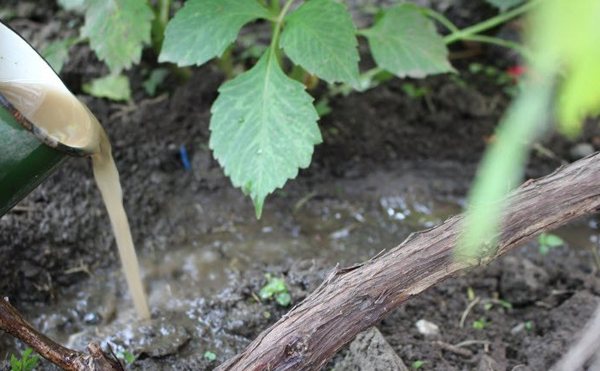

Watering is carried out, the timing of which depends on the autumn weather. If the crop has already been harvested and the air temperature is high enough in warm and dry autumn, it is necessary to water it immediately after harvesting the bunches. If the temperature matches the calendar temperature, it will be necessary to water the plant well in mid-late October. So that the nutritious moisture does not spread, but feeds the root system, the base of the stem is dug in shallowly and water is poured into it.
Top dressing of a young plant is carried out in September, for this they use the same trace elements as for adult grapes, but reducing the concentration of the nutrient solution by half. Top dressing, consisting of potassium magnesia (about 35 g) and superphosphate (about 50 g), has proven itself very well, dissolving these substances in one bucket of water. In October, feeding is repeated.
Treatment against diseases and pests
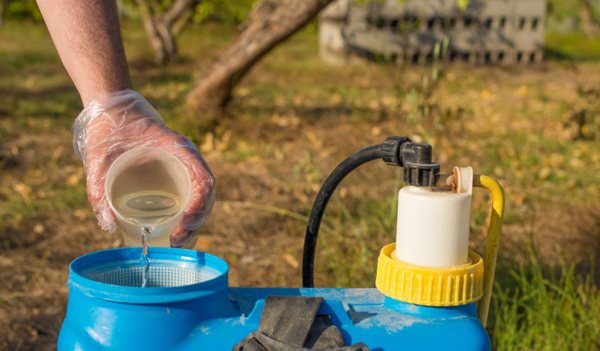

Autumn processing is designed to destroy wintering forms of insect pests and pathogens. This will allow young grapes to winter safely and maintain health by spring.
A popular and simple remedy is a solution of salt and soda (food grade). For a ten-liter bucket of water, take 5 tbsp. tablespoons of soda and twice as much salt. The water should not be cold. With this soda-salt solution, the grapes are completely processed, including the leaves. In September, you need to process the grapes three times.
Used for disinfection and disinsection and vitriol solution (iron or copper). A bucket of water is heated to hot (not less than 40 ° C) and a solution is prepared in it, for which copper sulphate is taken 100 g, and iron sulphate 400 g is sprayed with vitriol after laying on the ground, and the covering is not done until sprinkled mortar, the grapes will not dry out.
Nitrafen and DNOC are effective in combating pathogenic microbes and fungi, but they are highly toxic, and they take a long time to decompose in the soil, so they can be used every three years.
Overwintering vineyards are often damaged by hungry rodents. To ward off them, carbide is used (a tool used for welding). Calcium carbide is placed in clean metal small jars (from petroleum jelly, shoe polish, etc.) and placed under a shelter. When carbide absorbs atmospheric moisture, a chemical reaction occurs with the release of gas, the smell of which scares off rodents and destroys pathogenic microorganisms that cause diseases.
Pruning old grapes
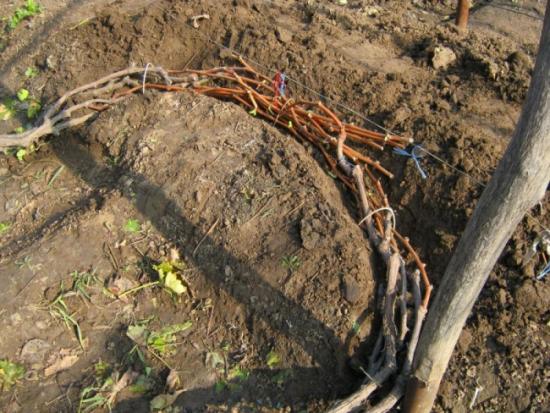

Pruning should be done after leaves fall after 2-3 weeks. At this time, the plant will be in a dormant state.It is not recommended to carry out this procedure earlier, since after the fall, the process of photosynthesis continues. The optimal time for pruning shoots is mid-September.
If this requirement is not met, pruning will disrupt the accumulation of nutrients. Tightening with trimming should also not be. With the onset of cold weather, the vine becomes very fragile, and any manipulation will lead to various damage. To create the correct shape of the bush, remove diseased, old and dried shoots. They are collected in a heap and burned. This will prevent pest larvae from spreading through the vineyard. Not only healthy shoots should be left, but also shoots that perform a spare function.
In the middle of autumn, the fruit link is formed. It consists of a knot and an arrow. In order for the link to develop correctly, the strongest shoots that have reached the wire are cut off. The replacement knot is a shoot that is located at the bottom of the bush. You need to cut it so that 3 eyes are visible. The upper shoot is cut, leaving 5-6 buds. This is a fruit arrow.
You need to cut off all shoots 20 cm long. If the shoots reach 30 cm in length, then only 10% of the entire branch should be pruned. After the procedure, lubricate the cuts with garden varnish. You can prepare it yourself using wax, paraffin, rosin and other substances.
This agent prevents rotting. This manipulation rejuvenates the bush, which allows you to collect a rich and large harvest. In addition, when cutting off the shoots, the berries ripen faster.
Why is the procedure needed
Any procedure performed on fruit trees and shrubs is primarily aimed at increasing yields. In addition, as a result of such a procedure, other important goals are achieved:
- an increase in the size of bunches and berries;
- improving the taste of berries due to the greater accumulation of sugars;
- acceleration of maturation;
- after pruning, compact bushes can be easily bent to the ground and covered for the winter period;
- diseased parts of the plant are removed, which is the prevention of diseases;
- facilitating work on the care of bushes and harvesting.
Prune the crop annually. Only in this case can one count on a good harvest.
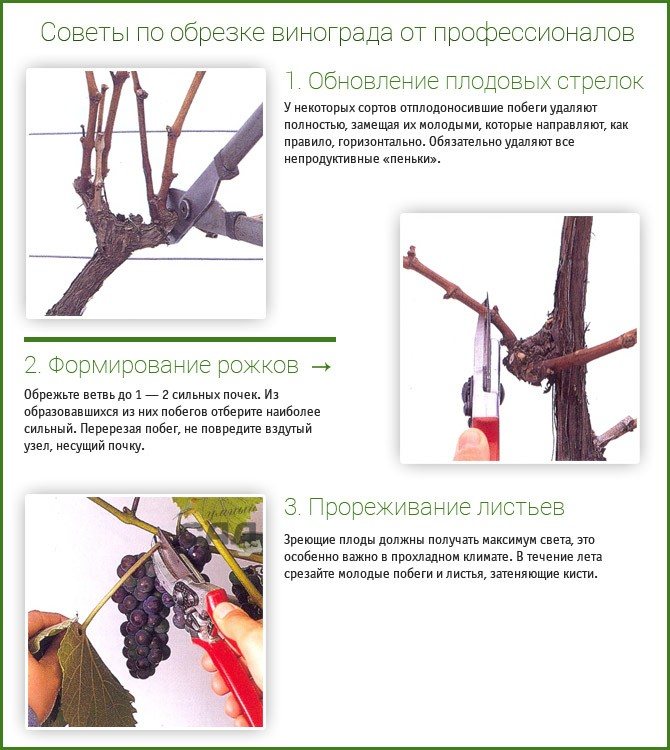

Pruning terms by region
The roots of a grape bush are more sensitive to frost than the aerial part. Based on this, when the average daily temperature drops to minus 6 degrees, all work with the grapes should already be completed: it should be cut and well covered for the winter.
Plastic substances continue to flow to the root system, even after the completion of the leaf fall. When enough of them accumulate, the vines will easily endure the winter.
Many growers carry out the pruning procedure in 2 stages:
- At the first pass, during September, they cut off parts of the shoots that did not have time to ripen by that time, as well as stepchildren.
- A second pass is planned for October, in which pruning is done according to all the rules.
In each specific region, pruning should be started when the temperature drops and the first night frosts appear. It so happens that in a series of warm days, cold weather suddenly sets in for 1 or 2 days. This is by no means a signal to start trimming. You should wait for the cold weather to come to your region for a long time.
According to long-term data, the average time for cutting grapes in autumn for different regions looks like this:
- The middle zone of the country and the Volga region. In these areas, the first ground frosts occur around the last days of October - early November. During this period, stable cold weather is already established with a temperature range from +5 to minus 5 degrees. It is at this time that you should start the pruning procedure on grapes. After it, you can immediately cover the culture for the winter.
- The capital of the country and the Moscow region.In these regions, the process temperature for grape pruning is set in mid-November. It is advisable to complete the work by the end of the last month of autumn.
- The city on the Neva and the Leningrad region. The region is located north of Moscow, so frosts are observed there earlier. You can start pruning in the northern area from October 10 and finish this work by the end of this month.
- Ural. The region differs from the rest of the harsh winters, so after pruning the grapes need to be well covered for the winter. And the trimming procedure must be carried out from 5 to 25 October.
- North of Russia. In the northern regions, winter is characterized by bitter frosts, and colds in the fall come there quite early. The process temperature suitable for pruning is set there at the junction of September and October. It is at this time, plus or minus 5 days, that the crop should be pruned with immediate subsequent shelter.
- South of the country and Ukraine. In areas with a mild climate and not very frosty winters, pruning begins from the end of November and ends before December 10.
- Belarus. The grapes are pruned during October.
Study the short-term weather forecast well before heading out to your garden to do your grape pruning. The weather can suddenly change and then the pruning time can shift in one direction or another.
Dates of the procedure
In addition to knowing how to properly cover the grapes for the winter, you also need to have an idea of the required timing of the operations. A considerable part of annual and young seedlings of grapes perishes from spring frosts. They do not have time to get stronger after planting and are damaged due to a sharp drop in temperatures. A similar effect is observed with autumn planting.
What happens if you don't cover the grapes?
The cultivation of grapes in Siberia, the northern and central regions is fraught with risks. Most of the varieties are capable of withstanding negative temperatures down to -15 degrees Celsius without harming the plant without harming the plant. With a decrease in indicators to -20 degrees Celsius within 4 days, a loss of up to 70% of fertile kidneys can occur. At the same time, not only the eyes on young seedlings die, but also on adult hardened shoots.
A great danger is posed by cold weather for the fibrous root system of vineyards, which can only withstand temperatures down to -6 degrees Celsius. Frostbite roots die and cannot be restored, unlike ground shoots, which can lead to the complete death of the bush.
When can you not cover your grapes?
Only vineyards that grow in areas where the minimum temperature does not drop below -16 degrees Celsius can be freed from shelter. In conditions with average air temperatures up to -20 degrees Celsius, only varieties with low frost resistance are covered. The presence of severe Siberian frosts requires an obligatory shelter.
To find out when to shelter grapes for the winter in the middle or northern lane, familiarize yourself with the temperature regime of your area and study the time of the onset of cold weather and the possible risks of frost. Shelter of grapes for the winter in the Moscow region and other cold regions occurs in the fall after harvest and foliage.
Removal of shelter from grapes occurs in the spring in the absence of the threat of late frosts. You can learn more about how to properly open a vineyard here. Removing winter shelters from the bushes, you will find healthy shoots ready to bear fruit.

